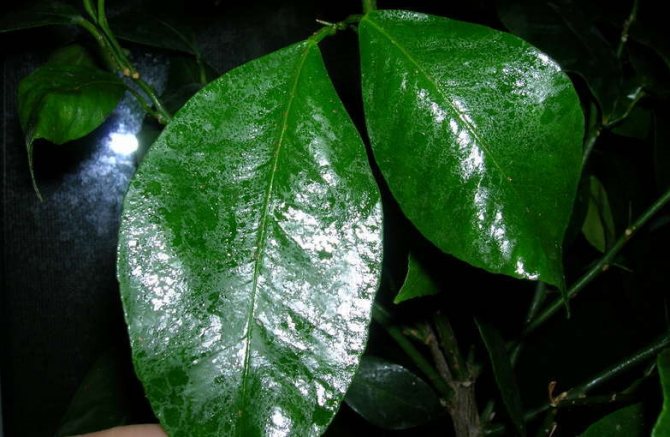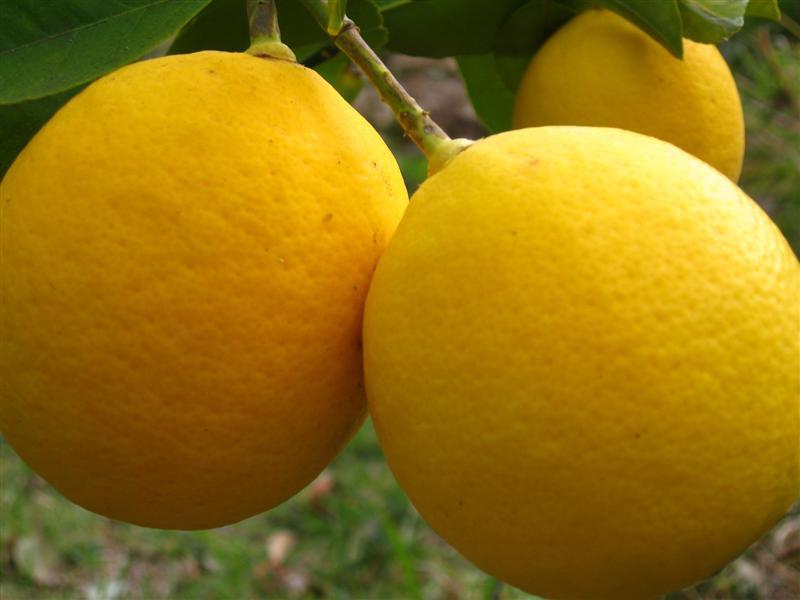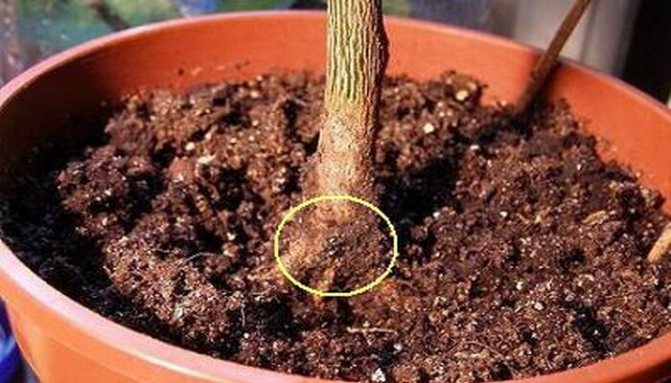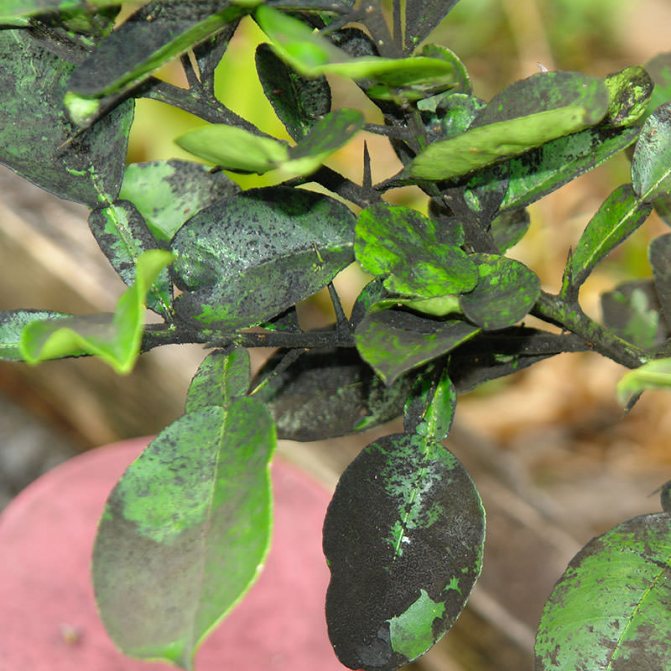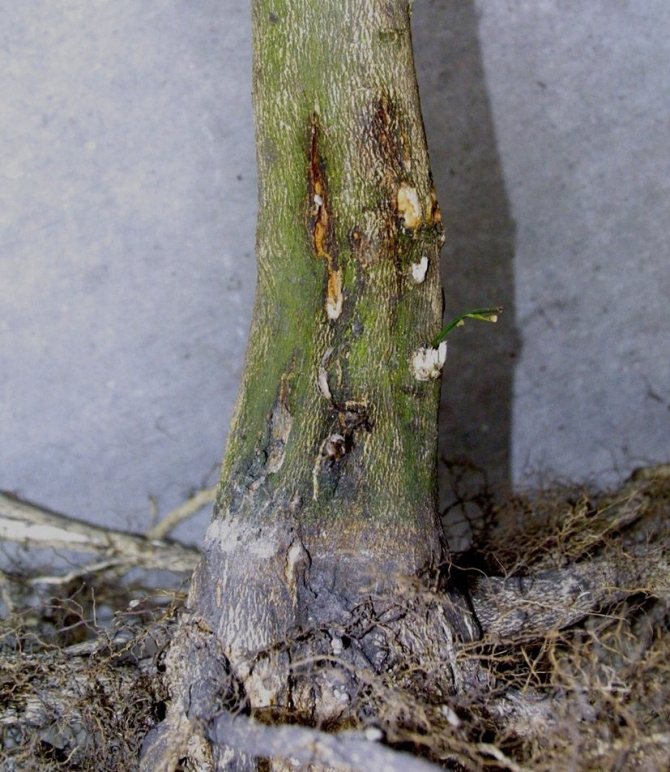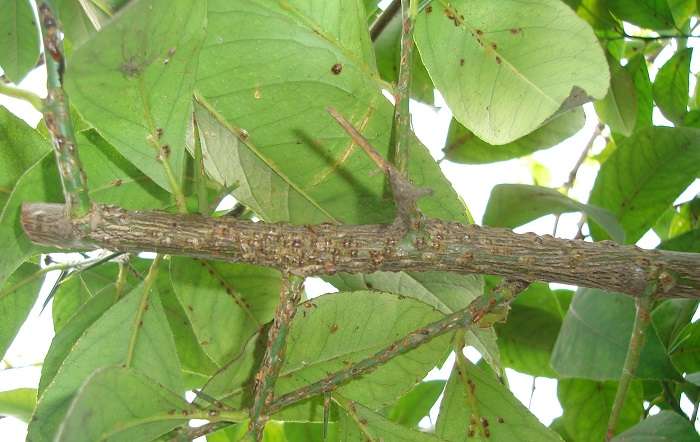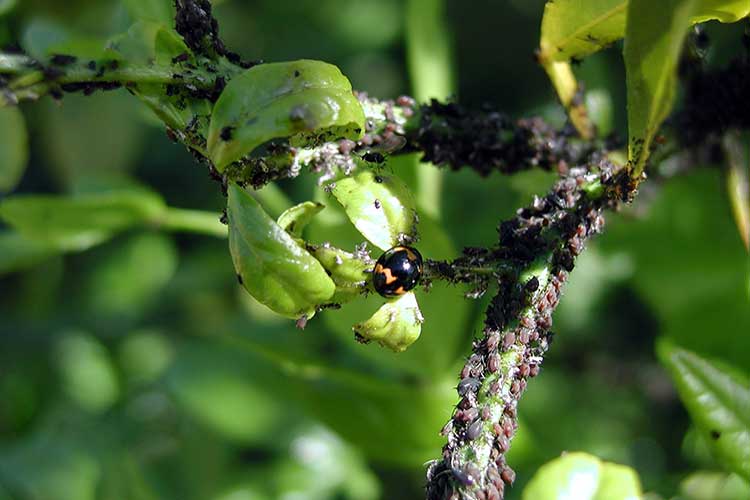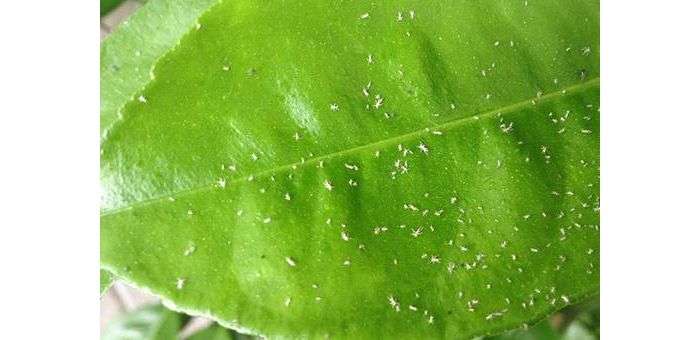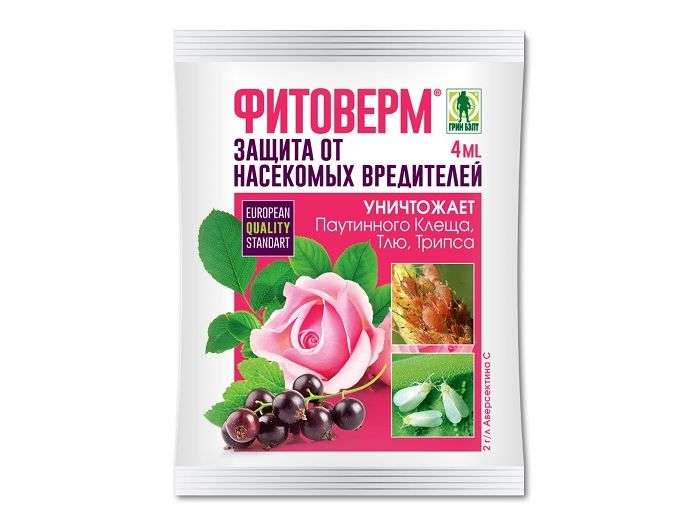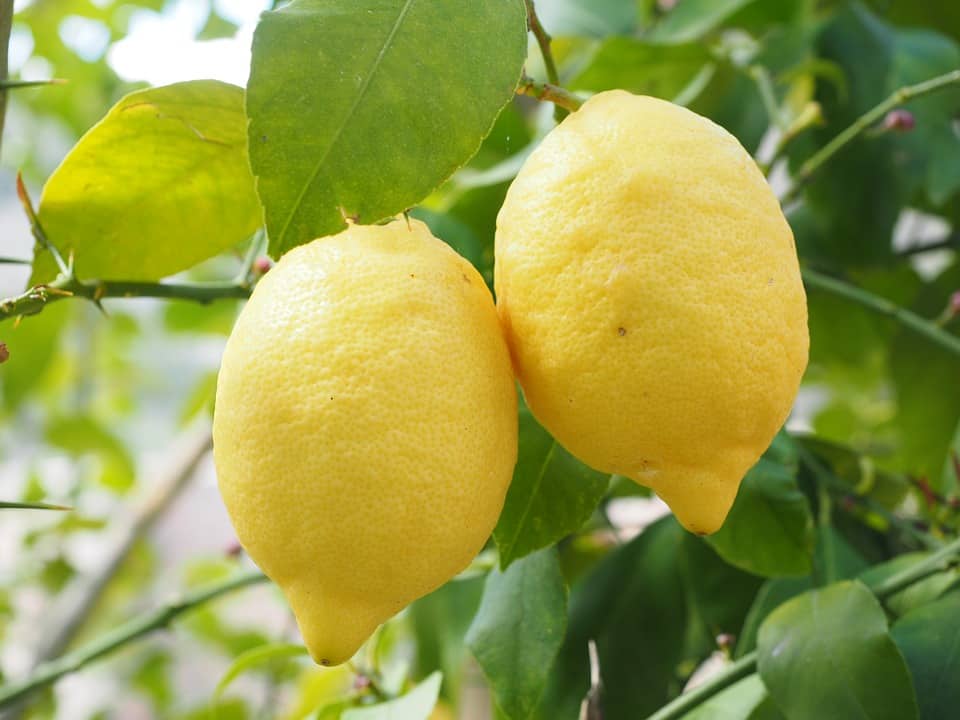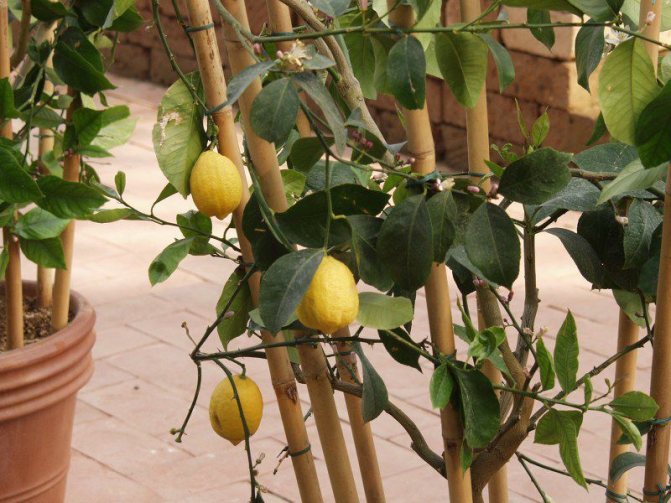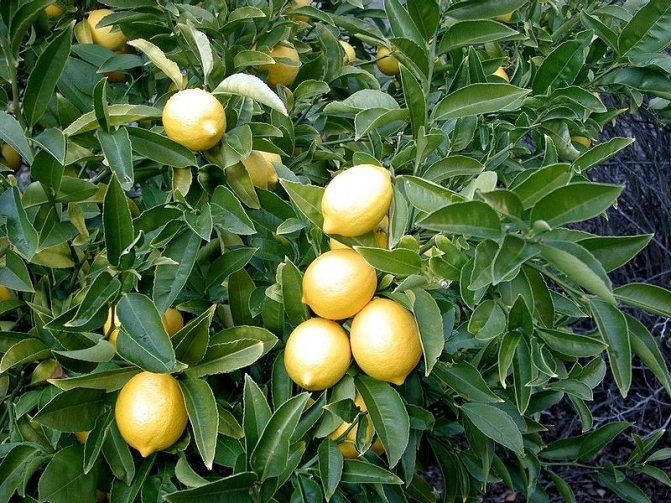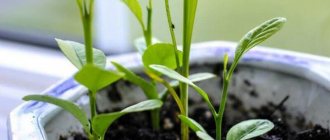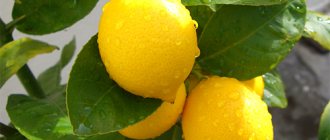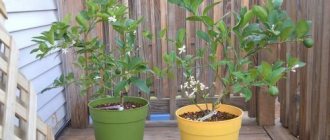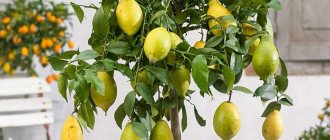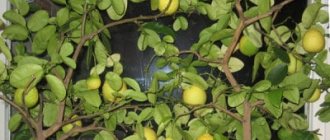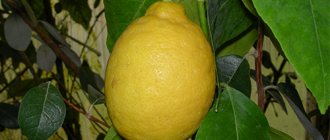.
Lemon is a useful plant whose fruits are used to boost immunity. To grow this tree, you need to properly care for it and know the diseases that are dangerous to it. Sometimes there is a sticky coating on the lemon leaves. It is necessary to find out the reason why such a neoplasm has occurred. Then it will be possible to help the plant.
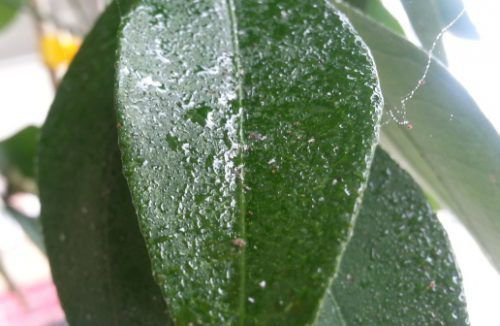
Sticky lemon leaves are a sign of disease
Cultivars suitable for self-cultivation
There are several varieties that grow and bear fruit well in apartments. The Pavlovsky variety can be called one of the best indoor lemons. This tree with leathery leaves and thorns can grow to a height of 1.5 to 2 meters. Fragrant flowers mainly appear in the spring and fall. The first fruits are formed from the age of three.
Fruits with a thin skin and a nipple at the top are colored in a light yellow tint. Ripe lemons weigh between 200 and 300 grams.
"Meyer". Trees with a small number of thorns, having a rounded crown, reach a height of 1 to 1.5 meters. Blooms powerfully throughout the year.
Fruits, colored bright yellow, weigh from 50 to 80 grams. "Meyer" stands out among other varieties with an excellent harvest (up to 50 lemons per year).
"Novogruzinsky". Trees grow up to 1.5-2 meters. Fruits weighing 120-150 grams have an elongated oval shape with a wide blunt nose.
Its indisputable advantage is its good adaptability to growing in rooms. The disadvantages include low yield (no more than 10 fruits per year).
"Kursk". The trees reach almost 2 meters. Fruits are gaining up to 300 grams. This variety must be pruned every year and formed a crown, as well as fed regularly.
"Ponderosa". Trees with a spreading crown and covered with thick thorns bear fruit weighing about 500 grams. The advantages include early fruiting (in the 2nd year), good tolerance to high temperatures and dry air, and the disadvantages are low yield (up to 5 fruits).
Causes and treatment of homemade lemon pests
Pests cause great damage to indoor flowers. They feed on the sap of their leaves, which negatively affects the overall health of the lemon. As a result, the tree develops slowly and loses its decorative appearance. The following are the main pests of indoor lemon and how to deal with them.
Shield
Homemade lemon can have sticky leaves. These are not symptoms of the disease, but the result of the appearance of a scutellum - a pest of brown, brown or white color, up to 2 mm long, having a wax shield on the upper body. The insect drinks juice from leaves and shoots, on the damaged areas of which yellow or red spots remain.
Under the influence of the scale insect, the lemon slows down development, its leaves turn pale and fall off. Insecticides Fitoverm or Actellik help to fight the scabbard. The affected areas of the plant are cut off, the remaining leaves are moistened with soapy water. A garden pitch is applied to the damaged areas.
Aphids are a dangerous lemon pest that sucks juices from plants, preferring young shoots. The body of the pest is pear-shaped, green, 1 - 6 mm in size. Aphid colonies appear more often in spring.Their activity leads to deformation of the leaves and inhibits the development of the lemon. In addition, insects carry dangerous viral diseases.
The pest is removed by hand, the affected shoots are cut off. Most of the insects are washed off with soapy water. In case of serious damage, the tree is sprayed with insecticides. Aktara and Fitoverm work best against aphids. Treatments are performed every 5 days.
Thrips
At home, lemon can be affected by the pest of thrips, small insects that live on the underside of the leaves. In adult parasites, the body is black or brown, up to 1.5 mm long, with two pairs of wings. The larvae of thrips, no more than 1 mm in size, are light yellow in color. They feed on the sap of the leaves, which leads to their deformation.
Thrips are most active in summer, in hot weather. Insecticides Decis or Karbofos are used against them. Good results are obtained by spraying the tree with an infusion of soap and garlic. The frequency of treatments is 2 weeks.
Spider mite
The spider mite develops within 30 days. Favorable conditions for the pest are low humidity and high air temperature. The mite feeds on plant sap, living on the back of the leaves. At the same time, not only lemon, but also other indoor plants are at risk.
Getting rid of the indoor lemon pest involves spraying the tree. To do this, choose insecticides of contact or systemic action: Fitoverm, Intavir, Karbofos. The stem of the lemon is sprayed with phosphorus or sulfur-based products. Folk remedies work well against spider mites. An infusion of garlic, onion or dandelion is used against the pest.
About tanks for planting, soils and drainage
For lemons, red clay pots that are not covered with glaze are considered the best. They allow the roots to breathe, as they allow air to pass through, and take away excess moisture.
Lemon tree primer can be found at specialty stores or centers, but it is also easy to make yourself. To do this, you will need leaf humus, sand (river), high moor peat, sod land, and sand is taken in one part, and sod land, peat - in two parts.
Important! For young plants, the soil should be lighter and looser (add two additional parts of peat), and for adult specimens it should be denser (due to the sod land).
Drainage must be poured into any container for growing lemons at the bottom. The size of the layer is from 2 to 5 cm. It is best if it is fine expanded clay.
Temperature regime
Temperature has a great influence on the growth and development of this culture. During the period of budding and flowering, 14-18 degrees is considered optimal. Fruits grow best at 14-24 degrees, and the largest growth occurs at 21-22 degrees. In autumn and winter, it is better to keep the plants in a bright place at 4-15 degrees.
Important! Large temperature fluctuations between day and night can cause drying and leaf fall. Also, the leaves fall off at temperatures above 35 and below 5 degrees.
Lighting
For the lemon to develop well, the length of daylight hours should be about 12 hours. Therefore, in winter, plants need to be supplemented with fluorescent lamps or special phytolamps. If it is not possible to organize additional lighting, then it is advisable to lower the temperature to 12-14 degrees.
Important! This plant does not like very much when it is rearranged from place to place. In order for the branches to grow evenly in all directions, the pots are periodically turned.
Prophylaxis
The best prevention to prevent disease and blemishes is to create optimal conditions for the growth and development of the lemon tree:
- Lighting... Place in the brightest part of the apartment, avoiding direct sunlight. In case of a lack of light, use special lamps.Daylight hours for lemons are 12 hours.
- Temperature regime... Comfortable temperature in summer - 18-22 degrees Celsius, in winter and spring - 16-18 degrees. In summer, you can keep it on a closed balcony. Avoid drafts.
- Humidity... General recommendations: summer watering - about 3 times a week, winter - 1 time a week. The number of waterings may vary depending on the air temperature. The main thing is that the soil is always slightly moist. At any time of the year, daily spraying is recommended, preferably not on the tree itself, but around it.
- Top dressing... Produced with special complex fertilizers for citrus crops. They comply with the terms and norms according to the instructions. In special cases (plant diseases), additional feeding is possible.
- Transfer... Up to 3 years of age, lemons are transplanted every year. Then transplants are reduced to 1 time in 2-3 years. The procedure is carried out in spring or autumn.
- Pruning... It is done in order to form the crown, stimulate fruiting, sanitizing, thinning thickened areas. Produced with sharp scissors or pruning shears.
- Features of the... Lemon does not like changing places and conditions; it takes a long and difficult time to adapt to a new environment.
A room lemon is rarely found in a city apartment. After all, its cultivation and maintenance is troublesome and laborious. But it's worth it: a well-groomed tropical handsome man is a real decoration of the house and a compliment to the caring hands of the hostess.
If you find an error, please select a piece of text and press Ctrl + Enter.
Growing lemon at home has many benefits. The owner of the citrus gets not only an evergreen perennial plant, but also healthy tasty fruits. The lemon tree is very beautiful and can decorate the interior of any house, apartment, office, etc. But often lemon owners have to observe how yellowish specks appear on its leaves.
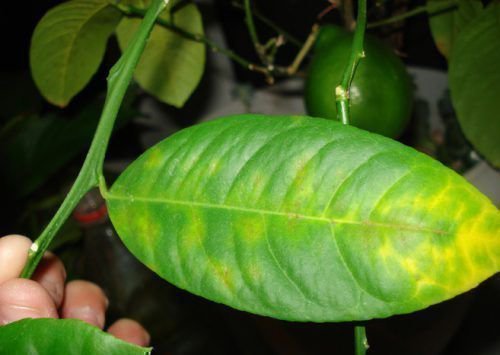

Yellow spots on the leaves are a common problem in lemon.
Any change in the state of the leaves of a tree is the plant's reaction to external factors.
Growing technology
Lemon care at home consists of watering, fertilizing, transplanting, pruning and forming a crown.
Watering and humidity
A well-developed lemon tree constantly needs regular watering. However, if the soil is always damp, then the roots suffocate from lack of oxygen, the substrate sour, and brownish spots appear on the leaves and they begin to fall off.
Watering the plant should be done carefully and preferably with soft water (temperature 22-24 degrees). Excess water from the pan is removed after half an hour.
Important! In the summer, the lemon is watered only when one third of the earthy coma dries out. And in cold weather, they start watering when two-thirds of the soil in the pot becomes dry.
The best humidity for this plant is considered to be 60-70%, but in apartments it usually ranges from 25 to 35%. Therefore, to increase the humidity, the crown must be sprayed with warm water.
Transfer
It is best to transfer this culture in the second and third decade of February before the start of shoot growth, avoiding damage to the roots.
Young lemons need to be handled annually, and adult specimens - after 3-4 years. In this case, the container is taken 3-5 cm more, and the tub - 8-12 cm. After transshipment, the plant is watered and placed for 2-2.5 weeks in a warm and shaded place.
Plants need to be repotted when the roots are completely entwined with the soil in the pot and are visible from the drainage holes. During transplantation, the upper part of the earth is removed, the blackened roots are removed, and the ends of the rest are trimmed. This procedure gives an impetus for the formation and growth of roots.
Top dressing
The lemon tree is demanding on nutrition, especially at the beginning of growth and during fruit formation.For top dressing, both organic and mineral fertilizers are used. They are brought in every 15 days.
Of the mineral fertilizers, nitrate (5 g per liter), potassium salt (2 g per liter) and superphosphate (5 g per liter) are used. Sometimes it is good to add magnesium sulfate (1 g per liter). And from organic matter - infusions from cow or poultry manure, which should be infused for at least 2-3 weeks.
Important: The temperature of the fertilizer solution should be 3-5 degrees higher than the room temperature.
Before the start of growth, trees are abundantly treated with a solution of ferrous sulfate (2 g per liter).
Why is it dropping leaves? What to do?
Let's try to figure out why the lemon tree sheds its leaves and what to do in this case.
Lemons come from places where they can get enough sunlight even in winter. On the lack of lighting indoor lemon responds by shedding green leaves. The plant is depleted and unable to provide food for all the foliage, and gets rid of the excess.
We talked about the rules for caring for indoor lemon in the winter in a separate article.
Read also: Spins for the winter from bell pepper
Reproduction methods
Lemon can be propagated by air layers, seeds, cuttings and grafting (budding).
Growing from the bone
It is not so difficult to get a lemon from a seed at home. It is advisable to plant the seeds immediately after they are removed from the fruit. They are placed in small containers with light air-permeable soil at a depth of 1 to 2 cm. In a moist substrate, they begin to sprout in 2-3 weeks, but the first fruits from such lemons can be obtained only after 8 or more years.
To speed up the appearance of the crop, you need to plant a one-year-old seedling (with a trunk diameter of at least 1.5 cm) with a cuttings or buds taken from a fruiting lemon. The grafted plant blooms for 2 or 3 years.
Graft
Much has been written about how to plant a lemon. But it is worth repeating the main points of this technology. For grafting, a T-shaped incision is made on the bark of a seedling (stock) and a bud (eye) is inserted into it, which was taken from a fruiting specimen. The place where the vaccination took place is tightly bandaged with tape from the bottom up. The best times for this are March and July.
We cut
You can easily and quickly get a fruiting tree using cuttings. This is best done from April to May. Cuttings are cut from young branches of a healthy tree 8 to 15 cm long with 3-5 leaves.
Cuttings cut at right angles take root most quickly. To prevent the lower cut from rotting, sprinkle it with crushed coal.
Rooting of cuttings occurs in wet sand at a temperature of 20 to 27 degrees in a place inaccessible to the sun. Heating the soil up to 27 degrees can accelerate the appearance and growth of roots.
The cut shoots are buried 1.5-2 cm, sprinkled with water and covered with a plastic bag or jar. In 1.5-2 months, the cuttings take root completely.
Important! Before you start rooting the cuttings, it is advisable to keep them in a heteroauxin solution. This will speed up the formation and growth of roots.
Finished seedlings are transplanted into soil consisting of leafy earth, sand and turf (2/1 / 0.5).
Problems with micronutrient deficiencies
Leaves that turn yellow often indicate that the lemon needs nutrients. The most common problems are zinc and magnesium deficiencies. Coping with magnesium deficiency is easy. It is necessary to check the pH of the soil. If the indicator is less than 5, then lime and peat must be added to the soil. The dose should be monitored. The pH value should not be higher than 9 units. Complex mineral fertilizers can also be used.
Zinc deficiency also has its own characteristics of detection.In addition to spots, with a deficiency of this element, the leaves become small and narrow. The uniformity of the color of the leaves also changes.
Zinc deficiency, manifested in the form of yellow veins, is replenished by spraying. Zinc sulfate is used for this. One spray is enough to replace the missing nutrient.
In a city apartment, lemon is rarely found. If you managed to grow this wonderful and fruitful tree, it will be a real decoration and dignity of your home, which you will not be ashamed to boast to your guests.


About diseases and pests
Among the diseases of the home lemon, the first place is occupied by root rot, which occurs when the soil is severely waterlogged. Because of this disease, the roots become brown, quickly rot and die.
But gray rot, which manifests itself in the form of brown-black spots on the leaves, or fusarium, in which leaves fall and shoots die off, are quite rare. The affected parts of the plants must be cut off.
When rust appears, the plants are treated with topaz.
Whitefly, spider mites, scale insects, mealybugs, thrips, aphids, miner flies - all these pests can annoy your green pet. If yellow spots in the form of dots appear on the lemon leaves, then most likely a spider mite has settled on them.
With a small number of pests, they are removed by hand, the leaves are wiped, and severely damaged shoots are cut off. In this case, lemons are treated with herbal preparations.
If there are many insect pests on the trees, then they need to be sprayed with neoron, fitoverm, actellik and a spark. It is worth remembering that one treatment is not enough, and they are repeated 2 or 3 times with a break a week.
In the process of growing indoor lemon, flower growers often encounter its diseases and pests. The affected citrus tree loses its decorative appearance, ceases to bloom, bear fruit, and often dies. Knowing the root causes of lemon disease and treating them at home can help you avoid growing difficulties.
The reason for the appearance of yellow spots on the leaves of the lemon tree
Lemon leaves are the weakest point of the tree. They indicate the appearance of plant health problems. Due to the action of external factors (errors in care, lack of moisture, diseases, etc.), their condition changes. They can be lethargic, thin, dry, and even discolored. The owner of the lemon must monitor the state of the citrus and prevent the action of any dangerous factors, because the health of the plant depends on it. Often, yellow spots appear on the leaves.
The reason for the appearance of signs of yellowness of the leaves may be simple hypothermia. Citrus is a thermophilic plant, although some varieties have long been adapted to cold weather. The tree reacts sharply to any changes in temperature. If the air temperature is less than 12 ° C, you need to turn on the heater, but do not move the lemon to a warmer place.
The plant does not tolerate moving and may even die from this. Another reason is nutritional problems. In this case, the leaves are covered with yellow spots of different sizes.
If the edges of the leaves are affected, then this indicates that the tree is not getting enough magnesium, and if there are problems with the veins, then zinc. You can correct your own mistakes in care with the help of feeding. Introducing the missing ingredient will create a nutritional balance. But sometimes the appearance of yellow spots depends little on the quality of plant care. Their formation may indicate a developed fungal disease or parasitic insects.
Why does lemon get sick
This exotic plant is affected by diseases and pests in the following cases:
- in the process of grafting with a diseased cutting;
- improper care: planting in contaminated soil, too frequent or rare watering, insufficient lighting, illiterate pruning or insufficient soil fertilization;
- the plant did not have time to get stronger after a previous illness;
- infection of healthy domestic specimens with street ones;
- the ingress of bacteria, viruses and fungi into the room during ventilation;
- making mistakes in the process of breeding, planting and transplanting.
Spots on the leaves
Yellow spots on the leaves... Yellowing of the leaves of a freshly purchased lemon is normal. The plant is trying to adapt to new living conditions. Why do the leaves turn yellow while at home for a sufficient time and what to do at the same time we will find out further. Most likely, leaves are sunburned or over-fertilization.
For all his love for sunlight, he should not receive them in the open. The pot should be kept on the south side so that there is adequate lighting, but the plant needs to be shaded slightly in the summer heat. If the reason is excessive feeding, then rinse the soil in the pot.
Brown spots on the leaves... Lemon leaves begin to darken, turn brown and acquire a rusty hue. with a lack of phosphorus... It starts at the tips of the leaves and then spreads to the sides of the leaf.
Fruits also suffer from a lack of this trace element. The rind becomes thick and they themselves take on an ugly shape.
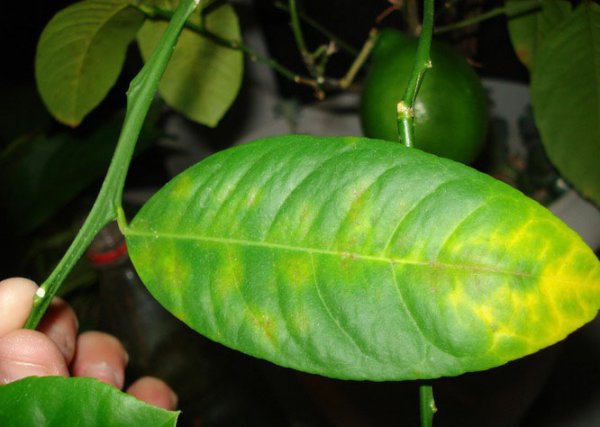

Viral
Diseases of indoor lemons caused by viruses lead to massive loss of leaves on the tree. After such sores, the plant becomes completely bare, often dying. It is advisable for beginner flower growers to familiarize themselves with their description and methods of struggle.
Sheet mosaic
Dark and light streaks appear on the leaves of the affected specimen, resembling a mosaic in appearance. Over time, they become pale or completely white, lose their shape. Young lemon leaves develop misshapen. With a leaf mosaic, the tree stops growing.
If a lemon gets sick with this disease, it is quarantined, away from healthy specimens. It is impossible to completely get rid of the leaf mosaic, since at the moment there are no drugs for this sore. All you can do is to alleviate the symptoms of its course by providing proper care, and above all, a balanced and regular feeding. Severely affected specimens must be destroyed.
Citrus Cancer
This disease on lemon leaves looks like brown spots. It is also characterized by the appearance of brown spots on the fruit. With a prolonged course of the disease, young lemon leaves are deformed and take on an ugly shape. The fruit shrivels and does not develop. Over time, such a specimen dies.
Treatment of this disease of home lemons is impossible, therefore, in order to prevent it, preventive measures are taken: treatment in the spring with liquid copper fungicides.
Tristeza
The first sign that tristeza has appeared on an indoor plant is massive foliage. Further, the bark and shoots die off, which are covered with brown spots. A specimen infected with tristeza cannot be treated and quickly dies.
Most often, lemons get sick with viral infections, subject to illiterate care and during a period of weakened immunity.
Signs of the phenomenon
Leaves of a healthy lemon are clean, firm, smooth, and have a deep green color. Unhealthy spotting manifests itself in different ways, depending on the underlying cause. The following changes should alert you:
- The leaf plates are covered with spots that do not have clear boundaries - stains. Some have a pronounced yellow color, others are barely noticeable.
- Almost all foliage suddenly and quickly turns yellow, loses its elasticity and smoothness.
- An edge burn is observed - the edge turns yellow and dries, the leaves fall off.
- The spots look like small specks that merge over time. A completely yellowed leaf falls off.
- On a part of the deciduous apparatus, rounded spots with clear contours appear. The number of spots increases and decreases markedly. Symptoms are observed for a long time, the plant gradually withers away.
- Round spots appear not only on the leaves, but also on all parts of the tree.
Fungal and infectious
Damage to lemons by fungus or infection at home is not uncommon. The reasons are the same as for infection with viral diseases.
Gomoz
The presence of elongated brown spots on the branches and trunk are the first signs of homoz. The bark under such spots quickly dies off and begins to crack. In places of cracks, a sticky, golden-colored substance is formed, which quickly hardens.
The main reasons for the development of home lemon disease are mechanical damage to the bark (fractures, cracks), high air humidity in the room, a lack of phosphorus-potassium fertilizers in the soil, an excess of nitrogen, planting in already infected soil, or too deep burial of the trunk.
It is worth treating a sick specimen in the following way: remove the infected bark on the trunk, cut off heavily affected shoots. Treat the stripping and trimming areas with any fungicide of 3% concentration and cover with garden varnish.
The duration of treatment will depend on the degree of damage to the tree. The treatment is carried out until brown spots no longer form.
Anthracnose
Of all diseases, indoor lemons are most often affected by anthracnose. It is determined that this sore appears on the lemon by the leaves: they fall off en masse. But first, the leaf plate turns white or yellow. Flower buds also fall. The fruits are covered with reddish spots.
Control measures are the removal of dead branches and infected leaves. Three times treatment of the affected specimen with the drug "Fitosporin". Another option is to treat the tree with a 1% solution of Bordeaux mixture.
Scab
They begin to treat the tree by spraying with 1% Bordeaux mixture. All affected parts on the crown are preliminarily removed.
Melseco
When melseco is infected, the branches of the tree at the tips begin to dry out, the leaves crumble en masse. On the cuts, the branches acquire a reddish tint.
The reason is improper care, or rather, lack of light in the winter. There is no point in fighting this disease, since all methods are useless. The only thing that is required of this is regular examination of the tree for symptoms.
Affected specimens are subject to destruction.
Root rot
Often, indoor lemons have leaves that fall off. When 1-2 leaves fall off, you should not worry: this is a natural process. In case of massive leaf fall, it is worth digging up a tree and examining its root system.
If the roots are dark, moldy and soft to the touch, the tree is affected by root rot. All decayed parts are cut off with a sterile knife or pruner. Places of cuts are powdered with crushed charcoal. Next, a transplant is carried out into a new flowerpot.
The transplanted lemon is placed in a well-lit place with protection from the scorching sun. Watering is allowed only a week after transplanting to prevent re-rotting of the root system.
Yellow spots from diseases
Yellow and brown spots often indicate that the plant has undergone a fungal or bacterial disease. Some of them cannot be treated and are very infectious to the rest of the plants kept near the diseased tree. One of these incurable diseases is cancer. When it is detected, not a minute should be missed, the tree should be disposed of. There is no point in leaving him in quarantine. There will be no signs of recovery, and the citrus will die sooner or later.
Another common disease is root rot. It destroys the root system of the plant, gradually killing it.The main reason for the appearance of signs of this disease is improperly prepared soil for planting. Citrus should be treated like this:
- Trim off all damaged areas of the plant roots.
- Transplant into a new pot with new soil.
- Apply mineral fertilizer.
One procedure is enough for the yellowness to disappear from the leaves. The fertilizer applied will help the tree heal damaged roots and restore its health and strength. Experienced florists recommend taking care of favorable microclimatic conditions for a sick tree. It should be organized full lighting, warmth, humidification.
Lemon does not like excess moisture, especially when it is damaged by rot. It is best to wipe the leaves with water or spray them after transplanting. And excess moisture in the soil can cause the appearance of fungal microorganisms.
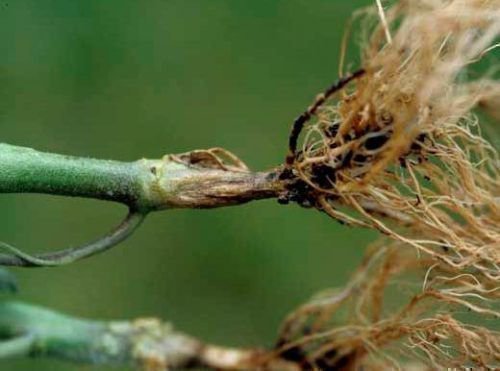

Root rot arises from improperly selected soil
Pests
In addition to fungal and viral diseases, there are various pests of indoor lemon.
Shield
Homemade lemon diseases are treated with insecticides or soapy water. For 1 liter of water, 2 tbsp is consumed. l. any liquid soap. All parts that bulge are processed.
After processing, the tree is washed under the shower. After 2-3 days, the treatment procedure is repeated.
Common aphid
With a minor lesion, they are dispensed with by cutting off the affected parts along with insects. If the aphid has spread to the whole plant, the crown is treated with garlic infusion (4 peeled and chopped garlic heads are infused in 5 liters of water for a day). Also, insecticides are used to treat infected specimens.
Root aphid
Notice how this pest appears is obtained by the appearance of the plant. It becomes lethargic, stops growing, the leaves become drooping and turn yellow.
Such a tree is removed from the pot, its roots are sprayed with a contact insecticide or a weak garlic infusion, and then transplanted into a new container, having previously sterilized the planting soil.
Spider mite
Often a spider mite appears on a lemon. These lemon pests appear in dry conditions and low indoor humidity. They affect young leaves and twigs. The appearance of a small web on a lemon indicates the spread of the mite.
The tick is destroyed at home using a four-fold treatment with 1% boric acid solution. The interval between treatments is 5 days.
If a lemon infects a spider mite, the humidity level in the room is increased and frequent irrigation of the aerial part is carried out.
Damage to leaves with a scabbard
A scabbard may appear on the leaves of the lemon tree. This pest is known for its camouflage. On the surface of the leaf, it forms small dark yellow dots, which outwardly resemble a dry bloom or scaly shell. You should start treating the tree as soon as possible, because these pests quickly spread to other parts of the citrus. Very quickly, pests fill the entire evergreen plant with their shells, due to which the foliage falls off, and the tree itself is exposed to infectious diseases.
All caring citrus owners know what to do with such an insect. When detecting dark yellow spots in the form of growths on the leaves, you must:
- Check the absence of growths on the branches of the tree (if any, they should be removed mechanically). The same operation is carried out with leaves.
- Wipe the foliage with an alcohol-based solution.
- Spray the tree with insecticide.
The scale insect lives in colonies. Therefore, it will take more than one day to treat lemon. Most often, a procedure with wiping the leaves and treating with insecticides is performed until the harmful signs completely disappear.
As an additional agent, you can also use mineral oil, which will immobilize insects and make them more vulnerable to the action of the active ingredients of the drug.


The parasite scale insect settles in colonies
Preventive measures
To prevent the appearance of diseases and pests on this exotic plant, the gardener requires not only compliance with agrotechnical rules, but also the provision of competent care. First of all, such measures should be aimed at increasing the immunity of the plant and its resistance to infection.
It is possible to prevent chlorosis (imbalance in the distribution of chlorophyll), to activate the growth and development of a plant, using the following composition in the diet of a house tree:
- ammonium nitrate - 15 g;
- iron vitriol - 3 g;
- boric acid - 5 g;
- potassium sulfate - 15 g.
The dry mixture is dissolved in 10 liters of water. Lemons are watered with a nutrient solution no more than once every 5 months.
This composition protects indoor citrus fruits from fungal, viral and infectious diseases. They gently stimulate healthy plant development.
A set of preventive measures
The main way to prevent pests and diseases from appearing on lemon is to follow the rules of agricultural technology. The tree should be planted in well-drained soil and should be provided with sufficient light and moisture.
Regularly it is required to inspect the lemon: all damaged shoots are removed, wounds or cuts are treated with garden varnish.
Important! Bouquets of flowers or infected plants, other possible sources of infection (fruits and vegetables from the garden) should not be kept near the lemon.
Typical diseases of indoor lemon and their treatment
Why do lemon leaves turn yellow and curl? Why does the plant shed its leaves? Why are lemon leaves covered with black spots? The reason may be improper care, lack of trace elements or flower disease. If the leaves fall, then the homemade lemon may lack lighting, it has been poured. Leaves fall off a lemon if the air in the room where it is located is dry, or the horse system is disturbed.
Most often, lemon leaves fall in the autumn-winter period, but leaf fall can be observed at any other time of the year. Main reason: unfavorable conditions. For example, a recently purchased plant may shed its leaves. The explanation is simple: in the greenhouses where it is grown, the conditions of detention differ from the microclimate in the apartment. Leaf fall is a reaction to a change in the microclimate of growth. After the purchase, the lemon must be acclimatized in the new conditions, it is undesirable to transplant it, it is provided with proper care. At this time, it is important not to overflow the flower, since the process of moisture evaporation is disrupted without leaves. Experts recommend spraying more than watering; epin can be added to the solution.
Why does a lemon shed its leaves if its place of growth has not changed? Reason: lack of light
... This plant belongs to the category of light-loving, that is, it needs 12-hour daylight hours. In the autumn-winter period, when the length of daylight hours decreases, the plant must be illuminated with a fluorescent lamp. It is better to place the pot on the west or east side of the house, you can also on the south, but with the obligatory shading.
Lemon shed its leaves if a transplant was performed with full or partial soil replacement
... In this case, the root system is disturbed, which is necessarily reflected in the crown. She crumbles. What to do? It is necessary to help the flower to restore the root system. To do this, watering is reduced, the flower is placed under a greenhouse (plastic wrap), which should not touch the leaves and branches of the flower. Spraying is carried out to maintain a high level of humidity in the greenhouse. Every day the greenhouse is ventilated for 15 minutes to prevent condensation.Epin is added to the spraying solution once a week, and root can be added to the irrigation solution. The greenhouse does not need to be abruptly removed. To adapt the flower, the airing time is increased every day. The greenhouse is completely removed when new leaves appear on the lemon.
Lemon sheds leaves when cancer strikes, viral mosaic
... All these diseases are viral in nature. In most cases, in indoor cultivation, diseases cannot be treated, and the plant is completely thrown away in order to prevent infection of other flowers.
Cancer on lemon leaves looks like irregular brown spots that dry out and crumble inside. With prolonged illness, young lemon leaves develop deformed and small. The disease cannot be treated; it can be prevented by spraying the flower with fungicides in spring.
Leaves fall if homemade lemon strikes leaf mosaic
... On the leaves, it looks like light spots of irregular shape, sometimes it spreads over the plate in the form of strokes. The mosaic is not treatable, the plant is removed in most cases.
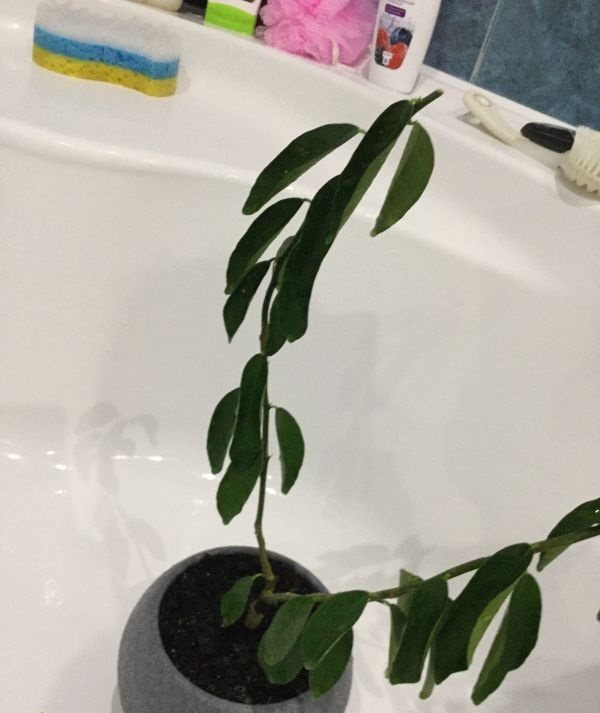

Leaves curl at the lemon if the irrigation regime is violated.
This is overdrying or waterlogging of the soil. In the first case, it is necessary to water the flower with small portions of water, but prevent waterlogging of the soil in the pot. In both cases, the plant is placed under a greenhouse, where it is regularly sprayed. Waterlogging of the soil in the pot leads to rotting of the roots. Damaged roots can no longer "drink" water, and therefore the plant suffers from a moisture deficit even in waterlogged soil. In this case, watering is stopped. The lemon is taken out of the pot, while the integrity of the earthen coma cannot be violated, and wrapped in paper. The latter will draw out excess moisture from the soil. Drying in this way is carried out within 3 days, the plant must be shaded. Then the flower is returned to the pot and a greenhouse is organized for it. Watering is not carried out, much attention is paid to spraying.
Lemon leaves dry around the edges if the room temperature is high and humidity is low
... The optimal temperature regime for lemon is + 20 ... + 23 degrees, humidity - not lower than 70%. Otherwise, the plant is sick. Very often, the leaves of a room lemon turn yellow, if it is located close to heating devices in winter. The plant does not like dry air, and even in winter it may suffer from a lack of light. It is illuminated with a fluorescent lamp.


Leaves turn yellow and fall if a lemon infects a spider mite
... In this case, a white bloom will be present on the back of the leaf plate, and a light, whitish cobweb will be present on the branches. The leaves are covered with small spots. How to treat? It is necessary to wash the plant under the shower with warm water, then treat with one of the preparations Fitoverm, Vertimer (three times with an interval of 10 days) or Akarin, Neoron (4 times with an interval of 7-10 days). It is better when the affected flower is isolated from the rest of the collection.
How to Treat Homemade Lemon Diseases
The indoor lemon is an evergreen citrus plant that is grown for decorative purposes and for exotic fruits. With improper care or infection, lemon diseases occur, which can be dealt with with timely and proper treatment.
general information
The question arises why such a famous citrus plant, which can be bought in almost every flower shop, is so low in popularity. The unpopularity of the lemon is due to the difficulty of keeping it, the fear of ruining a chic and rather expensive tree. Citrus needs special care and the care of a grower. Lemon can be susceptible to various diseases and parasites. For normal growth and ripening of fruits, special care and conditions are needed, similar to the hot tropics, where this plant comes from. When breeding a lemon tree, yellowing, drying out and early fall of leaves becomes a real disaster. Knowing the information will help you grow a healthy strong lemon tree and enjoy its fruits for a long time.
Causes of lemon diseases
Citrus fruits do not get sick as often as ficuses or flowering ornamental plants. There are several reasons why lemon loses its decorative effect, shrinks and fades away. This is improper care, lack of micro and macro elements, waterlogging, lack of light, drafts and other environmental factors.
Diseases of lemons: sooty fungus on the leaves
Another group of reasons is infection with pathogens and viruses. These are bacteria, fungi, insects as carriers of diseases. With improper care and lack of nutrients, the following problems arise:
- light yellow spots on the leaves - lack of nitrogen;
- drying out of the edges of the leaf blade - lack of phosphorus;
- dropping of the ovary - lack of boron and manganese;
- the appearance of a light mesh on the shoots - a lack of iron.
Such problems are solved by introducing the necessary trace elements with irrigation. More serious diseases caused by microbes and viruses require the use of fungicides.
Diseases
This is one of the most negative factors that affects the color change of foliage. Most diseases cannot be cured.
- Wart, or scab. A disease in which foliage and fruits are affected by a fungus. The first symptoms are yellow spots, which later become dark gray warts. After a while, they cover all the leaves and the trunk of the plant.
- Malsecco. A disease, as a result of which yellow streaks appear on the foliage, after which the leaf rolls up and falls off. The disease cannot be treated, the culture must be disposed of.
- Dark brown spotting. A disease in which yellow spots of irregular shape appear on the foliage. Subsequently, they turn orange, and they cover the entire leaf. This disease also cannot be cured, and the culture must be destroyed.
- Phylostictosis (brown spot). A disease in which brown spots with a rim appear on the leaves. They mainly appear on the lower leaves.
- Late blight. The disease affects the bark and foliage of the tree. When affected by this disease, the bark swells, and dark spots appear on it. Then holes appear, from which a yellowish liquid oozes, later turning red. Dots appear on the foliage that blur with oily spots.
- Tristeza. The disease is viral. During a simple form of the disease, the foliage turns yellow or turns orange. This is followed by the dropping of foliage, and then the wilting of the rhizome. The disease is not cured.
Infectious diseases
The causes and treatment of home lemon diseases depend on the nature of the pathogen. If cracks appear on the trunk of a tree, gum oozes from them, leaves fall off and the tree dries up - this is gommosis. Lemon fruits become soft and unpleasant in taste and smell. The disease is treated with a solution of copper sulfate, which is used to treat the affected trunk. The lemon is transplanted into a different soil.
Sooty fungus is the second most common disease of citrus grown in greenhouses. Signs of a sooty fungus:
- dark spots in the form of plaque on the leaves, stems and trunk;
- citrus growth slows down, young greens fall off.
Treat the disease by washing the shoots and trunk with warm soapy water. Carry out regular treatments under a cool shower. The room is regularly ventilated.
Scab is an infectious disease that first affects the trunk and then the entire plant. Signs of scab:
- dark convex tubercles on the leaves;
- cracks in the trunk;
- dark spots and holes in the fruit.
To combat the disease, the plant is removed from the pot and treated from roots to top with a solution of copper sulfate. Transplanted into a different soil. Affected fruits and leaves are burned.
To increase the plant's immunity and protect against diseases, citrus is treated in spring with a solution of liquid copper and suspicious leaves and fruits are removed. The plant is regularly fed with complex fertilizers, kept in a lighted room with regular ventilation.
Diseases of indoor lemon can be of fungal, viral and bacterial origin. They are spread through insects, water droplets when watering and spraying. It is important to remember: a healthy plant is less susceptible to diseases than a weakened one. That is why at home it is simply necessary to provide the flower with proper care and microclimate. The main thing in the treatment of a flower is the correct and timely diagnosis, adequate actions to eliminate the disease. So, indoor lemon diseases, their description with a photo, effective treatment from specialists.
Causes of spotting and ways to get rid of the problem
A correctly diagnosed and timely measures taken will quickly get rid of the problem, while preserving the plant.
Pests
Surprisingly, various pests often appear on indoor lemons. Pests can get into the room:
- with contaminated soil;
- with a bouquet of flowers or new houseplants;
- from the street - through a window or outerwear.


The most common pests include:
- Shields and false shields:
- feed on the juice of various parts of the plant, damaging the stems, leaf plates and lemon fruits;
- produce a sticky substance that disrupts the processes of respiration and photosynthesis of the plant and is a breeding ground for fungi;
- reduce the protective properties of wood.
- Mites - spiderweb, citrus and Yuma mite:
- leaf-sucking insects that prefer young leaves;
- form a kind of cobweb in the depths of rolled leaves, disrupting photosynthesis;
- spread viral plant diseases.
You can identify plants affected by insects by the following signs:
- characteristic yellowish or reddish-brown dots appear at the puncture sites of the leaf surface;
- the tips of the leaves turn yellow, the plate rolls up;
- leaves change color to yellow, then brown;
- foliage dries up and dies off;
- flowers and ovaries dry up and fall;
- a cobweb appears (at a late stage of tick infestation);
- tree growth stops, it "starves";
- the plant dies.
Ways to fight
Getting rid of harmful insects is not easy:
- pests multiply very quickly, spreading over the infected tree and neighboring plants;
- scabbards are covered with shields that reduce the effects of poison;
- ticks go through unfavorable periods, going into hibernation and hiding in the smallest crevices and soil.
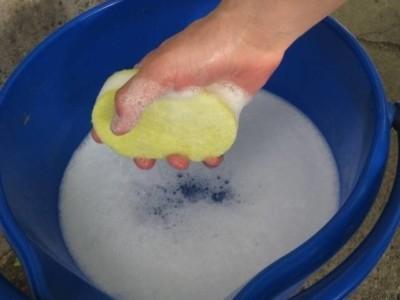

By combining various methods of control, you can increase the likelihood of complete destruction of pests:
- Mechanical... Putting a plastic bag on the container with the plant, wash the leaves with a solution of laundry soap and warm water or wipe with a napkin dipped in this mixture. After an hour, rinse the leaves under the shower. Repeat the procedure in 2-3 days.
- Chemical... A wide range of pesticides will allow you to choose the most effective pest control. Processing is carried out several times with an interval of 7-10 days. The use of this scheme will allow first to destroy the adults, and then the larvae hatched from the eggs.
Diseases and their treatment
Indoor lemons are often affected by infectious, viral and fungal diseases.which is related to:
- the exactingness of all citrus fruits to growing conditions;
- improper care of plants.
The most common lemon diseases:
- Late blight- a fungal disease that affects all parts of the plant. On the leaves it appears as oily yellowish spots that turn brown over time. Weakened plants are most susceptible to late blight.
The development of the disease is facilitated by air humidity above 90% at a temperature of 18-20 degrees. Treatment must be started as early as possible, otherwise it will be difficult to save the tree.The following methods are used to save citrus:
- careful examination of the plant (including the root system) and removal of all affected parts with the capture of healthy wood up to 10-12 cm;
- processing of sections with a 10% solution of copper sulfate;
- spraying the whole tree with fungicides containing copper (copper sulfate can be diluted in a ratio of 1 tsp. to 2 liters of water).
The emergence and development of infection is associated with regular waterlogging of the soil or injury to the roots during transplantation. Treatment is as follows:
- removal of rot-affected roots to clean cuts;
- processing of sections with crushed activated carbon or sulfur powder;
- complete replacement of the soil in the container;
- watering no earlier than 7 days after transplantation (to avoid relapse);
- processing leaves with wet wipes;
- diffused lighting for at least 12 hours a day (supplementary lighting if necessary).
Lack of micronutrients


The condition of the tree and its deciduous apparatus directly depends on the amount of essential nutrients. Spots on the leaves may indicate a lack of the following chemical elements:
- Iron... Yellow spots fade over time, the leaves dry out and fall off.
- Potassium... Spots of yellow-bronze color against the background of a darkened leaf plate covered with folds.
- Manganese... The upper leaves of citrus fruits are variegated: gray-yellow stains appear between the green veins.
- Zinc... Spots of bronze and gray-brown color are randomly located on abnormally small leaves. A yellow speck appears on young leaves.
Typical diseases of indoor lemon and their treatment
Why do lemon leaves turn yellow and curl? Why does the plant shed its leaves? Why do lemon leaves get black spots? The reason may be improper care, lack of trace elements or flower disease. If the leaves fall, then the homemade lemon may lack lighting, it has been poured. Leaves fall off a lemon if the air in the room where it is located is dry, or the horse system is disturbed.
Most often, lemon leaves fall in the autumn-winter period, but leaf fall can be observed at any other time of the year. Main reason: unfavorable conditions. For example, a recently purchased plant may shed its leaves. The explanation is simple: in the greenhouses where it is grown, the conditions of detention differ from the microclimate in the apartment. Leaf fall is a reaction to a change in the microclimate of growth. After the purchase, the lemon must be acclimatized in the new conditions, it is undesirable to transplant it, it is provided with proper care. At this time, it is important not to overflow the flower, since the process of moisture evaporation is disrupted without leaves. Experts recommend spraying more than watering; epin can be added to the solution.
Why does a lemon shed its leaves if its place of growth has not changed? Reason: lack of light
... This plant belongs to the category of light-loving, that is, it needs 12-hour daylight hours. In the autumn-winter period, when the length of daylight hours decreases, the plant must be illuminated with a fluorescent lamp. It is better to place the pot on the west or east side of the house, you can also on the south, but with the obligatory shading.
Lemon shed its leaves if a transplant was performed with full or partial soil replacement
... In this case, the root system is disturbed, which is necessarily reflected in the crown. She crumbles. What to do? It is necessary to help the flower to restore the root system. To do this, watering is reduced, the flower is placed under a greenhouse (plastic wrap), which should not touch the leaves and branches of the flower. Spraying is carried out to maintain a high level of humidity in the greenhouse. Every day the greenhouse is ventilated for 15 minutes to prevent condensation.Epin is added to the spraying solution once a week, and root can be added to the irrigation solution. The greenhouse does not need to be abruptly removed. To adapt the flower, the airing time is increased every day. The greenhouse is completely removed when new leaves appear on the lemon.
Lemon sheds leaves when cancer strikes, viral mosaic
... All these diseases are viral in nature. In most cases, in indoor cultivation, diseases cannot be treated, and the plant is completely thrown away in order to prevent infection of other flowers.
Cancer on lemon leaves looks like irregular brown spots that dry out and crumble inside. With prolonged illness, young lemon leaves develop deformed and small. The disease cannot be treated; it can be prevented by spraying the flower with fungicides in spring.
Leaves fall if homemade lemon strikes leaf mosaic
... On the leaves, it looks like light spots of irregular shape, sometimes it spreads over the plate in the form of strokes. The mosaic is not treatable, the plant is removed in most cases.
Leaves curl in lemon if the irrigation regime is violated.
This is overdrying or waterlogging of the soil. In the first case, it is necessary to water the flower with small portions of water, but not to allow waterlogging of the soil in the pot. In both cases, the plant is placed under a greenhouse, where it is regularly sprayed. Waterlogging of the soil in the pot leads to rotting of the roots. Damaged roots can no longer "drink" water, and therefore the plant suffers from a moisture deficit even in waterlogged soil. In this case, watering is stopped. The lemon is taken out of the pot, while the integrity of the earthen coma cannot be violated, and wrapped in paper. The latter will draw out excess moisture from the soil. Drying in this way is carried out within 3 days, the plant needs to be shaded. Then the flower is returned to the pot and a greenhouse is organized for it. Watering is not carried out, much attention is paid to spraying.
Lemon leaves dry around the edges if the room temperature is high and humidity is low
... The optimum temperature regime for lemon is + 20 ... + 23 degrees, humidity is not lower than 70%. Otherwise, the plant is sick. Very often, the leaves of a room lemon turn yellow, if in winter it is placed close to heating appliances. The plant does not like dry air, and even in winter it may suffer from a lack of light. It is illuminated with a fluorescent lamp.
Leaves turn yellow and fall if a lemon infects a spider mite
... In this case, a white bloom will be present on the back of the leaf plate, and a light, whitish cobweb will be present on the branches. The leaves are covered with small spots. How to treat? It is necessary to wash the plant under the shower with warm water, then treat with one of the preparations Fitoverm, Vertimer (three times with an interval of 10 days) or Akarin, Neoron (4 times with an interval of 7-10 days). It is better when the affected flower is isolated from the rest of the collection.
Main reasons
Lack of light
There are main reasons that contribute to the yellow spots on lemon leaves. One of the factors that affects the discoloration of a plant's leaves is a lack of light. The place of origin of lemon is in the hot tropics, where there is enough sunlight and warmth. Therefore, for keeping a plant at home, it is worth providing the most permissible degree of light, at least 6000–7800 lux, and throughout the year. This can be achieved in several ways:
- choose the most illuminated area of the apartment for the plant, preferably on the south side;
- use objects that reflect light to enhance the natural emission of light (foil, mirror);
- apply auxiliary artificial lighting using special lamps.
However, when trying to supply the plant with enough light, do not overdo it.The sun's rays can cause leaf burns, which contributes to yellow spots.
Other reasons
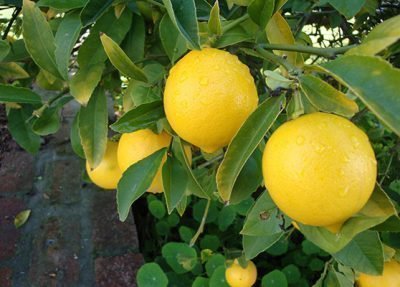

Experts identify a number of reasons due to which stains may appear. After reading them, you will find a solution to your problem.
- Improper watering. As a result of a deficiency or excess of moisture, the functioning of the roots fails, due to which the plant receives an insufficient amount of nutrients, responding to this by changing the color of the foliage to yellow or dropping it.
- Failure to comply with the temperature regime. The citrus plant responds negatively to temperature failures. The answer to temperature fluctuations and drafts is dropping and yellowing of leaves.
- Dry air. Lemon leaves change color to yellow when the air is dry. The acceptable degree of air moisture for lemon is 60–70%, and the required temperature is +18 ° C. This can be achieved by spraying the plant with water.
- Lack of nutrients. Lemon is quite picky about the composition of the soil and the beneficial substances included in it. Citrus responds to an insufficient amount of them with yellowing and shedding of leaves.
- Parasites. Most often, a citrus plant becomes a victim of attacks by parasites such as scale insects, scale insects, aphids, whitefly and spider mites. All of these pests drink juice from foliage and stems, which contributes to yellowing, wilting and shedding of foliage.
- Natural factors. If the citrus has 1-2 yellow leaves in the lower part of the plant and the yellowing does not go further, do not worry and wonder what to do. This is a natural phenomenon - new leaves will grow to replace old ones.
Tick attack
The leaves of the lemon tree can be eaten by several types of mites. They leave behind small yellow dots, and the surface of the leaf becomes grainy and then turns yellow.
It can be a citrus red mite, a spider mite, or a Yuma mite. These species are most often found on lemon trees. The undersides of the leaves may be covered with tiny cobwebs. Use a magnifying glass to confirm or deny the appearance of these pests on your lemon.
How to cut indoor lemon?
In order for the lemon tree to bear fruit well and be of the correct shape, you need to regularly prune and turn the tree over on the windowsill relative to the sun every two weeks. You can straighten the trunk by tying the branches with copper wire. This way the branches will grow in the right direction.
If the lemon already has fruits, then when ripe it should cut off not only the fruit, but also a branch 5-7 cm longwhere the harvest grew. And after a week, new shoots will grow at the cut site.


To obtain a fragrant tree with fruits, it is necessary to cut it
If you have too many fruits on the tree, then you need to adjust their number. at the rate of 1 fruit per 10-12 leaves. All other lemons need to be removed so that the plant is not very hard. Shape your plant to keep it fruitful and healthy.
Is it possible to plant indoor lemon outside?
Very helpful plant a lemon outside. Choose a place that is not too open and lighted. The best option would be a place where before lunch the sun, and after - partial shade. Expect the lemon to shed flowers after transplanting. But this is not scary, such is the reaction of the plant to stress during transplantation.
If you don't want a lemon without flowers, plant the plant outdoors in a pot. Thus, the tree will be in the same conditions, but already in the fresh air.
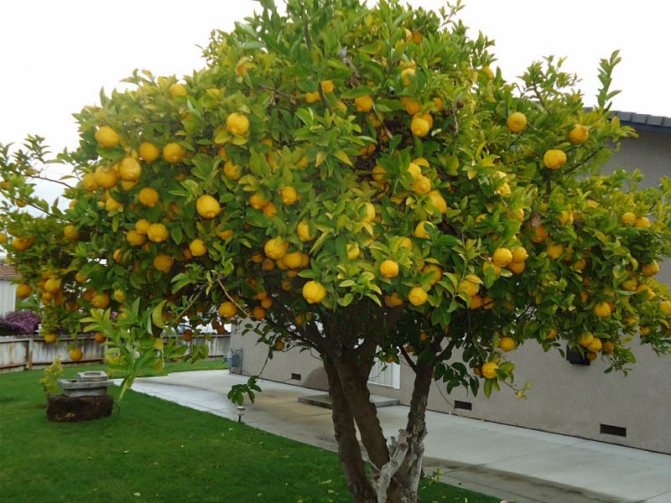

Be sure to plant indoor lemon outside during a warm season.
In good climates, lemon will grow on the streets.f the whole summer season... In October, it is advisable to return it to the room, because there may be night frosts and the plant may freeze slightly.
In any case, do not delay the stay of the indoor lemon on the street - as soon as the temperature starts to drop, it is necessary return to the premises.
Careful care and compliance with the listed measures will allow an exotic guest to settle in your house for a long time - room lemon, which will surely delight you bright greens and delicious citrus fruits.
What lemons are sick with
The lemon tree is a living organism, so it can get sick, of course. Lemon tree ailments are most often bacterial or fungal in nature.
An ailment such as citrus cancer, which is a very contagious infection of a bacterial nature, provokes the appearance of round yellow spots. Moreover, not only leaves are affected, but also fruits, and even branches.
Ailments such as citrus peel and oily spots are of fungal origin and also begin with the appearance of yellow spots, which in the first case quickly become scabs, and in the second variant they acquire a brown tint.
Although the store soil in pots with lemon trees is subject to sterilization, there is still a risk of infection with late blight or root rot when a plant is transplanted into a soil mixture that was formed on its own. Depending on how badly the roots are affected, lemon leaves may turn yellow or fall off altogether.
Aphid tricks
A small light green insect called aphid, multiplying rapidly, infects the leaves, trunk and shoots of indoor lemon and sucks out all the juices from the plant, as a result of which it dies. Aphids can be detected with the naked eye, since they are clearly visible on the vegetative parts of the plant. After an aphid attack, the leaves of indoor lemon become sticky, curl and dry out.
To combat this pest, every 7 days, the affected areas are washed with a solution of laundry soap. Garlic water also helps, for the preparation of which it is necessary to chop the head of garlic and fill it with hot water (200 ml), then leave it to infuse for 2 days. Such water should be applied to the affected areas of the plant every 5 days.
Care rules
The occurrence of many lemon diseases is associated with care errors. To minimize the risk of infection, you should carefully monitor the conditions of the plant:
- Air temperature. The optimal range is 18-23 degrees. In the cold season, it is desirable to provide lemon "cool wintering" at a temperature of 5-10 degrees.
- Watering. The most important nuance when growing citrus fruits. Water the lemon only after the topsoil has dried out with warm filtered or settled water. In summer, it is advisable to arrange a warm shower for the plant once a week.
- Top dressing. It is advisable to use organic fertilizers: humus or wood ash.
- Pest control. It is necessary to periodically inspect the plant and fight harmful insects in a timely manner.
Lemon diseases are serious enough and can lead not only to leaf defects, but also to the death of the entire plant. It is important to follow the rules of care and not forget about disease prevention measures. To keep the plant healthy, you should use decontaminated soil, provide sufficient watering and timely pest control.
Why do lemon leaves turn yellow
Gooseberry diseases and their treatment
Leaves of indoor lemon turn yellow, because:
- The wrong lighting was chosen (direct rays of the sun provoke the appearance of burns, excessive shading, especially in the cold season, does not allow the plant to fully develop).
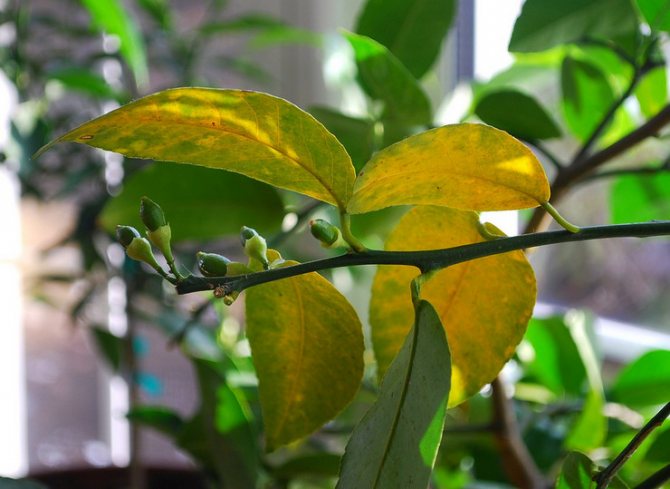

Lemon with yellowing leaves - Insufficient or excessive watering, which are equally dangerous for lemon.
- Violation of the usual temperature regime causes stress in the plant, which leads to negative consequences. Lemons thrive in the 14-25 ° C temperature range, but 20 ° C are ideal for them.During airing (especially in autumn or winter), it is recommended to take the lemon out of the room in order to avoid a sharp temperature drop. Central heating batteries or other heating appliances should not be in the immediate vicinity of the pot.
- Increased or decreased level of humidity in the room (optimal from 60% to 70%).
- Irrational or irregular feeding. Lemon needs nutrients, but too much is not good for your pet.
Reasons for the poor health of culture
Lemon is a plant that is demanding on the conditions of detention. It will react to many mistakes in care with a deterioration in well-being. The main causes of plant ailments are:
- weakening of the plant's immunity (often caused by maintenance errors);
- errors in care (excessive watering, incorrect temperature range);
- insect pests (aphids, scale insects, mealybugs);
- diseases of a viral and fungal nature.
Scab and other lemon leaf diseases
Lemon can also infect scab, which can be recognized by raised spots that appear on the leaves, branches, citrus fruits. After a while, instead of these spots, holes form, after which the leaves fall off, the fruits and bark of the branches crack. The causative agent of scab is a pathogenic fungus that can hibernate in fallen leaves, spread by wind and insects. It develops rapidly in humid environments.
To prevent this disease in the spring, the crown and soil should be sprayed with a solution of copper or iron sulfate. The diseased plant is sprayed after bud break with Bordeaux liquid. Secondary spraying is carried out after flowering. To do this, you can use copper oxychloride, cuprozan and other fungicides.
Tristeza
This is a disease caused by the Tristeza virus of the same name. In an infected tree, the bark of the trunk dies off. It affects the entire plant.
1053; Young trees under 5 years of age are most susceptible to this disease. The virus infects the entire plant. The initial symptoms of this disease are growth retardation and shrinking of fruits.
Other symptoms of tristeza: - Whitened veins of leaves.
1046; silts appear as if filled with liquid, thick and light. Soon the leaves turn yellow, dry up and fall off. - Damage to wood trunks and branches. Longitudinal convex grooves appear on the bark, the contour of the branch cut becomes uneven. Between the roots and leaves of the tree, the flow of water with dissolved minerals is disturbed, the leaves do not receive enough nutrition. The tree is oppressed, it withers and soon dies.
But there are varieties of lemons that are immune to tristeza. In such plants, the virus can be in a dormant state and not manifest itself in any way. But such resistant plants are carriers of the virus. Therefore, when using cuttings of such plants for grafting, you can infect another, healthy plant. Tristeza does not respond to treatment, so it is recommended to destroy the diseased lemon.
Scabbard on lemon: how to get rid of, prevention
It is worth separating sticky and white patches. The causes of such neoplasms, as a rule, are excessive watering or pests. Next, we will consider in detail why this or that type of plaque occurs.
The sticky coating that appears on the bark and leaves of the lemon tree is a big annoyance for the gardener. Transparent, its consistency resembles sprayed syrup. There are several ways to eliminate the liquid, and in order to determine the most suitable one, it is worth first finding out the cause of the sticky layer.
Regular inspection of the plant and temporary prevention of possible diseases can prevent unfortunate consequences.
It is necessary to periodically remove all dried leaves from the plant. It is also important to monitor the temperature and water conditions. The plant needs to be washed several times a month. On clean plants, pests start up much less often.You can wipe the lemon with soapy water, which will prevent the appearance of various pests.
If you find an error, please select a piece of text and press Ctrl Enter.
Scales (Diaspididae) are small insects 0.5-5 mm in size from the order of hemiptera.
The insect got its name from the dense shield that covers its body. The scutes have strongly pronounced sex differences. The females lack legs and wings, and often also eyes, but this is compensated for by a powerful protective shell that helps them survive the scabbard on your homemade lemon and tangerine, it would seem even when all methods of dealing with it have already been used.
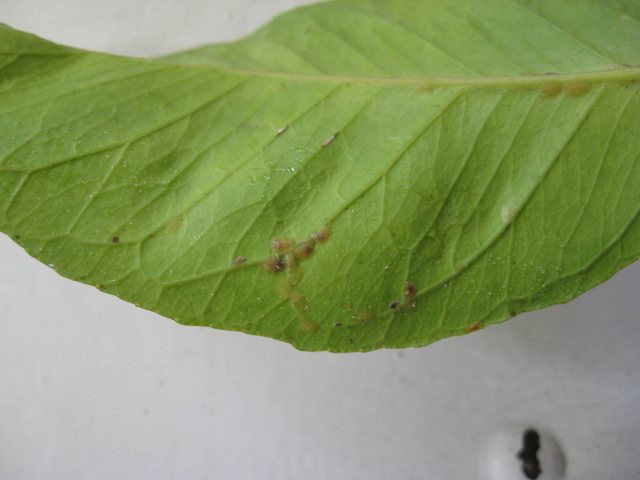

Scabbard on a lemon leaf is often located along the nutrient veins.
Males are slightly smaller in size, they have normal legs and one pair of wings, a flat slightly elongated shell and an underdeveloped mouth apparatus. The fate of the males of this pest, in fact, cannot be envied - after the act of mating, they die. The female scale insects can be found much less often than males and they are completely motionless. It is not at all sweet for males - to look for a long time, but as soon as you find it, then all life is over.
There are many varieties of scale insects, almost all of which harm various plants. These insects are fertile and reproduce rather quickly. These insects feed on plant sap, which they drink from different parts of the tree.
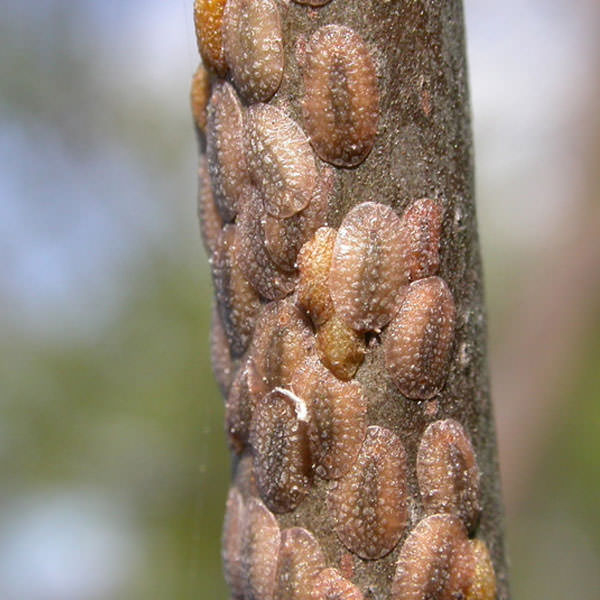

Adult scale insects with a shell on the trunk of a plant
Basically, these parasites reproduce with eggs, laying them in large quantities, but there are also viviparous species. You can find a scale insect on a lemon on both sides of the leaf, and also on the trunks of the tree. Young scale insects move very actively, thereby settling in all parts of the plant and sticking to them. Becoming an adult, scale insects lose their ability to move.
The scabbard on indoor plants, as a rule, carries significant efforts to combat it. Homemade citrus fruits are no exception. In the process of feeding this insect with the juice of the stems, leaves and fruits of the lemon tree, lesions with characteristic specks (yellowish or red-brown) appear on them.
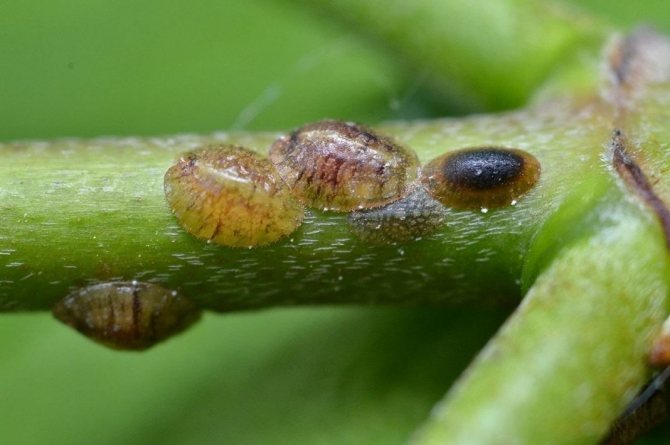

If not taken during the measure, then the shield will cause great damage to the plant.
In the process of vital activity, the scabbards produce pad - a sweetish liquid. By covering the leaves, it disrupts the photosynthesis and respiration of home lemon, and is also a favorable breeding ground for the sooty fungus.
ways of infection
Scabbards can get into the apartment together with infected flowers from the store, planting material (soil). Larvae can be carried in by the wind through open windows. It is also important to keep in mind that these insects primarily attack weak or diseased plants. Therefore, it is worth keeping such trees separate from healthy ones.
What are the signs that you can tell that your indoor lemon is infected with scale insects?
It is difficult to detect these insects at the larval stage, since they are small and move quickly enough. Adult insects are easy to see with the naked eye. They look like brown or light brown round scales on leaf plates or trunks.
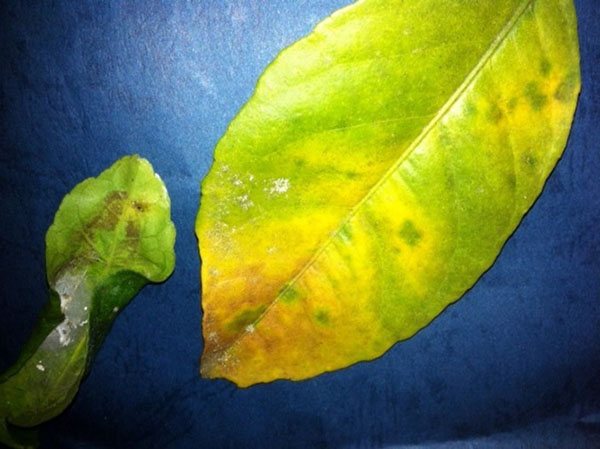

Signs on a lemon leaf affected by a scabbard
Yellowish or red-brown spots appear on the leaves of the plant - traces of parasite feeding.
If there are too many scale insects on citrus, they accumulate along the veins of the leaves, so they seem to be covered with bloom.
Another sign of a scabbard infestation in homemade lemon is sticky, sweetish spots of liquid on the leaves. Sometimes it can become so much that it begins to flow down from the leaves.
If scabbards have appeared on your lemon, it will be quite difficult to get rid of them. The shield protects the parasite from the action of poisons, and intensive reproduction contributes to the rapid spread of these insects throughout the plant. If measures are not taken in time, the fight against the scale insect on the lemon can drag on for a long time, and the citrus can die, losing all the leaves.
Read more: Dessert Apricot OKS - Apricot
How to cure lemon scabbard?
Mechanical method
The first and easiest way is mechanical. We put a package on the pot with the plant, then you need to moisten a cloth in soapy water or alcohol and try to wipe the pests from the affected areas of the plant.
The more scabbards you can wash off, the better.
Chemical methods
Since the scale insect is a rather insidious and highly protected pest, without pesticides, alas, it cannot be defeated. How to treat lemon from scale insects?
It is possible to cure citrus by various means. To destroy it, there are various insecticide preparations: "Aktara", "Aktellik", "Fitoverm" and others.
Fitoverm is sprayed over the surface of plants, and it acts upon contact with a pest. For him, only young vagrant larvae are vulnerable, since the carapace-carapace of adult scale insects is a good defense against poisons.
A more effective remedy against scale insects on lemon and tangerine will be Aktara and Aktellik. These are the so-called systemic insecticides, they also have an intestinal contact effect. Unlike phytoverm, they need not only to spray the crown of lemon and tangerine, but also to water it at the root.
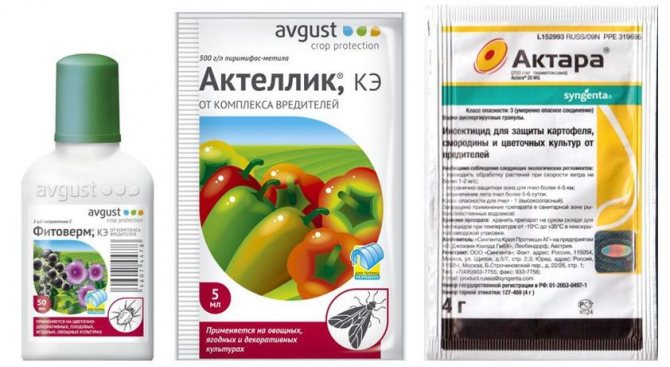

Means for combating scale insects on lemon
The rule is that if the larvae are young, have appeared recently and have not yet acquired a shell, then we process it with phytoverm. If Pavlovsky lemon has been affected by the scabbard for a long time and the pest colony has already settled on the plant quite densely, the individuals are adults, then we use systemic insecticides against the scabbard.
Also, karbofos can be considered as control methods: you need to treat the plant with a weak solution, first taking it out onto the street or balcony (this treatment can only be carried out in the warm season).
The top layers of the soil after such treatment of the plant should be replaced with a new one. The treatment should be carried out 3 to 5 times with an interval of 15 days in order to destroy those larvae that emerge from the laid eggs.
A significant disadvantage of such methods is that after processing the citrus, you cannot eat the fruits from it, since pesticides can remain in them and cause harm to health. But this is not scary, if the plant can be saved, then after a while new ones will naturally appear on it.
It is quite difficult to fight against scale insects on lemon. Therefore, it is easier to prevent their occurrence by observing the following preventive measures:
- It is necessary to monitor and promptly cut off dead and weak shoots, they are especially attractive to pests. You should also monitor the cleanliness of the soil in the pot.
Weekly washing of citrus fruits under the shower will also not be superfluous - after all, the accumulation of dust on the leaves and dry air have a detrimental effect on the plant. You can simply wipe each leaf thoroughly on both sides with a wet cloth.
You should not put bouquets of fresh flowers or diseased plants next to your citrus, they can become a source of infection for your plant.
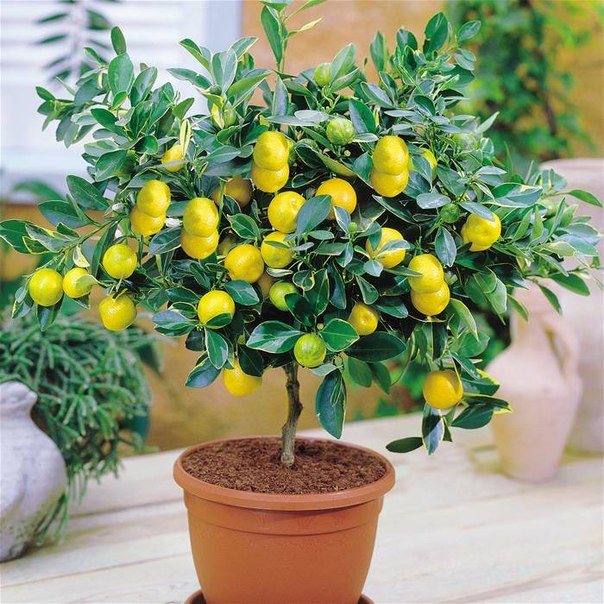

The secret of plant well-being is care, attention and knowledge of how to apply it!
Compliance with these preventive measures will not only help reduce the risk of scabies, but also help protect the lemon from other parasites, such as aphids, spider mites and others. Leaf problems can also be caused by other lemon diseases and pests.
The most common "guest" on citrus fruits is the scale insect. This is a very small insect. And not everyone knows what they look like and how to deal with them.
Scabbards often infect lemons and other citrus fruits.
A little about the shield
Scabbards have an amazing feature - they freeze on the stems of plants until their body is covered with a waxy film. Such a shield protects the pest from the effects of chemicals. Hard insect shield:
- helps to hide from human eyes;
- serves as a disguise;
- complicates the fight against insects.
There are many varieties of scale insects. Among them: black, spotted, oval, patterned, round and yellow-brown. All varieties are harmful to plants.
The scale insect is very prolific and reproduces rather quickly. Feeding on the sap of plants, this insect is a great danger. The leaves are covered with a thick layer of sticky liquid.This slows down the processes of photosynthesis and plant respiration becomes impossible. Sticky secretions create a favorable environment for fungal infections. They create a nutritious soil for the sooty fungus. Its presence is determined by the appearance of black spots that affect the leaves and stems.
The camouflage color helps the insect merge with the lemon bark.
Control measures
Lemon can become infected with a scabbard from nearby flowers, purchased fruits or bouquets from nearby. Therefore, constant monitoring of the condition of all flowers in the house will help to avoid infection.
Getting rid of the scabbard is difficult. Therefore, the best way would be preventive measures. Indoor lemon does not tolerate dry air, dust and cluttering of plants. When favorable conditions are created, the lemon tree will be healthy and constantly delight with beautiful fruits.
If homemade lemon grows worse, the leaves are crushed and turned yellow, then you should suspect the presence of pests. Most likely it is a shield. It's hard to see her. The adult insect is almost motionless. But the damage it causes is quite significant, especially for young plants.
Causes of the appearance of diseases in homemade lemon
There are many reasons for lemon disease. Diseases are usually divided into the following groups:
- Lemon infectious diseases;
- Damage by pests;
- Diseases of lemon in case of non-observance of the rules of care.
The largest group is infectious diseases. They are divided into the following groups: fungal infections, bacterial infections and viral infections, from which conventional drugs do not save. Lemon is susceptible to many infectious diseases.
Most diseases can be treated, some have not been cured. Also, lemon is affected by harmful insects. Not all types of pests of indoor and garden plants live on citrus species. But it is necessary to carefully inspect lemon trees, especially if they are outdoors in summer.
Diseases of lemon arising from improper care in room conditions are the easiest to eliminate.
It is only necessary to correct the maintenance regimes of the lemon tree so that it goes on the mend. In advanced cases, the plant weakens and one of the infectious diseases develops.
Plant pests
Shields
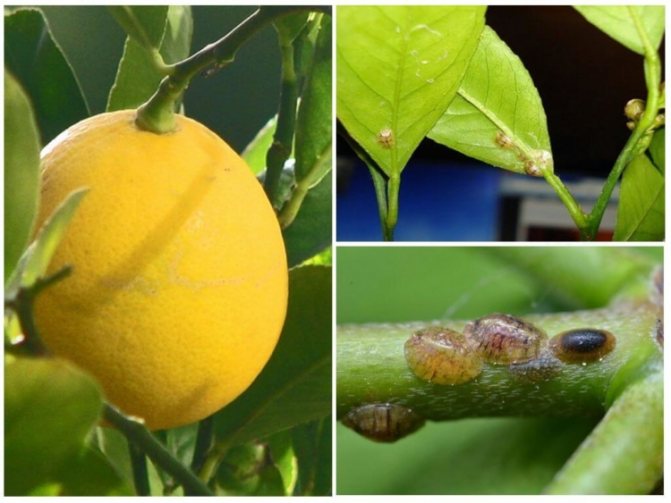

Scabbards feed on the sap of plant leaves. It settles on the back of the leaves. Despite its small size, it is visible to the human eye. The bottom of the leaves should be carefully examined to prevent the appearance of the parasite. Insecticides (for example, diazinon) are used to destroy the scale insect.
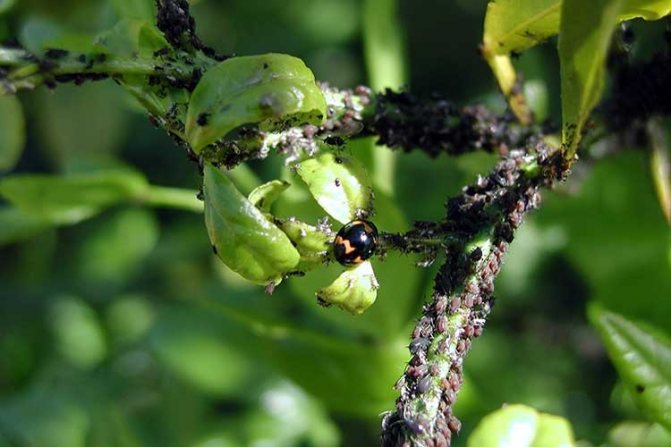

Aphids settle on young shoots that have not yet been covered with bark. The pest first affects the bottom of the leaf, then moves higher, simultaneously sucking the juices of the plant. As a result, the leaf curls up and dies.
You can fight aphids by cutting off the affected parts of the plant, if the parasite has not yet spread. Otherwise, you will have to resort to using an insecticide or infusion of garlic (4 heads are soaked for a day in 5 liters of water). After spraying, most of the insects die.
Mealybug
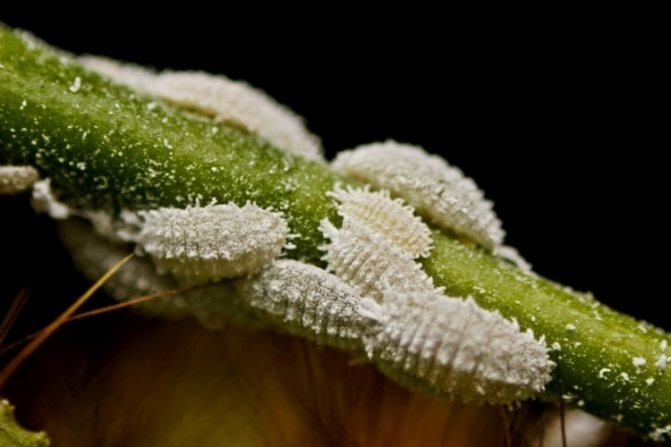

Mealybugs are close relatives of the scale insect. They are clearly visible on the plant even with the naked eye - their clusters resemble cotton wool lumps. Depending on the species, pests affect the leaves and root system of the lemon, slowing growth, causing yellowing and curling of the leaves.
If untreated, the plant may die. To combat the worm, chemical preparations (Fitoverm, Actellik) or alternative methods (for example, garlic infusion) are used.
What kind of soil is suitable for indoor lemon?
Lemon is a very whimsical plant and will not grow in any soil. In order to plant a citrus tree in a pot, you can use the soil from the store (special bags with soil marked "For citrus fruits"), or make the desired mixture yourself.
Young lemon soil mix is composed of turf and leafy soil in a ratio of 2: 1 and sand with humus in a 1: 1 ratio. For a more mature plant, the amount of sod land increases by one indicator and will be 3: 1 in the ratio with leafy ground.
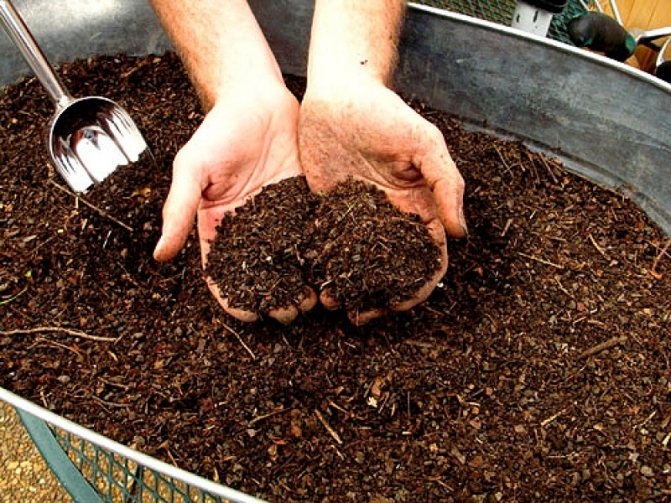

You can buy lemon primer at the store or make your own.
A particularly good addition to such soil is rotted oak leaves. It is a very breeding ground for the root system of the citrus tree.
Do not plant the plant in land from under the flowers or just dug up on the site. The lemon will not only stop growing, but may simply die in such conditions.
Bacteria and viruses
Disease-causing bacteria are no less a threat to the plant than parasites. The fight against them is very important. Leaf diseases are most common and are affected first. Treatment should be started at the earliest stages of the disease for greater efficiency and speedy recovery. The greatest danger to lemon is carried by such diseases:
- sooty fungus;
- scab;
- wartiness;
- root rot.
The latter attacks the root system, affecting the nutritional center of all citrus fruits. The diseased plant dies very quickly. Therefore, at the very first signs of rot (drying of the leaves and stem), the lemon should be transplanted to a new place. But this procedure has its own characteristics.
It is possible to save citrus fruits from rot only by replacing the soil with a new one. The affected roots must be shaken off the ground, the dead areas must be removed and the plant must be placed in a potassium permanganate solution for 1 hour. This procedure destroys pathogens. After 60 minutes of staying in the medicinal solution, the plant is dried and planted in a new place. Fertilize your lemon regularly to restore its healthy appearance.
Some diseases can be treated quickly. The fungus is one of those. Due to the attack of harmful microorganisms, the plant slows down its growth and dries slowly. It is difficult to confuse such a disease with another, since it is characterized by an ash coating that forms on the leaves. Do not be afraid of these symptoms.
It is not difficult to cure the plant. You need to thoroughly rinse the affected areas under running water or wipe them with a sponge. And as a preventive measure, you should regularly ventilate the room in which there is a pot of citrus fruits.
Scab often attacks home vegetation. This disease is characterized by the formation of spots on the leaves and stem. They darken quickly and make the leaf brittle. The affected areas can become soft, and their spread leads to the fact that part of the plant simply falls off. It is difficult to cope quickly with such a disease. The affected leaves should be removed and the healthy part of the plant should be treated with copper sulfate. And so that the disease does not bother citrus and later, it is important to carry out seasonal spraying. The same methods of treatment correspond to wartiness, the main development of which is associated with the destruction of the crop.
Unfavourable conditions
Lemon leaves may have yellow spots on them as a result of improper care or adverse environmental conditions.
A lack of magnesium and zinc, cold damage, excessive watering of the plant leads to yellowness. Also, the cause may be a violation of the acid-base balance in the soil.
Any changes in environmental conditions that occur suddenly can also cause the leaves to turn yellow. This may be the case when the plant is watered with cold, not settled water. In such a situation, the air temperature becomes much higher than the soil temperature. Also, fluctuations in humidity and room illumination are important.
Why do lemon leaves curl?
One of the common diseases of homemade lemon is leaf curling.
Phlox diseases and their treatment: why leaves curl
The causes of the disease:
- 1) Violation of the rules of care (most often improper moisture in the soil and air).
- 2) Lack of mineral fertilizers (deficiency of calcium, boron or copper in the soil).
- 3) Lack of fresh air.
- 4) Damage to the plant by various pests (both on the crown of the tree and on the root system).
Important! Mineral fertilizers are applied very carefully, as their overdose negatively affects the plant.
How to understand that the plant is missing something and needs to be treated?
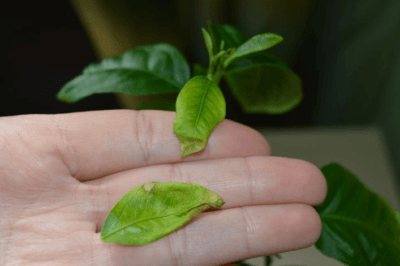

The plant is quite whimsical and will quickly make it clear that mistakes have been made in caring for it, or an infection has joined. You can suspect that a lemon is not feeling well by the following signs:
- a white or transparent sticky bloom forms on the leaves (the symptom indicates the presence of parasitic insects);
- leaves turn yellow or turn brown (both due to illness and as a result of care errors);
- dots or spots appear (with sunburn and infection);
- the tips of the leaves dry (from disease, damage to the root system or improper watering);
- leaves curl (as a result of improper care or infection);
- lemon drops leaves (can be both a reaction to changing conditions of detention, and a sign of a serious illness).
Citrus pests at home
Lemon is the plant that, unfortunately, often attacked by various parasites, such as:
- Shield.
- Spider mite.
- Mealy blackberry.
- Nematode.
- Aphid.
- Garden slug.
Scabbard: how to get rid of it?


Scabbard is the most common tree pest. The first sign of its presence is a sticky coating on the lemon leaves. On the leaves and branches, bulges of about 4 mm appear, almost imperceptible to the eye. Coated with a dense wax shell, they become immune to chemicals.
You can fight sticky leaves insecticides... During watering, the poison from the leaves is washed off into the soil, absorbed by the roots and the plant becomes poisonous.
You can also fight the scabbard using folk methods. They are very effective, but more troublesome.
Washing leaves with soapy water several times a day until the pest disappears completely. Mix green soap (5g) with anabazine sulfate (2g) and dissolve in warm water. Rinsing is performed once a week, followed by rinsing off the solution with water every other day.
Spraying with a solution of soap and kerosene... To do this, 5 g of soap and 10 g of kerosene are dissolved in a liter of warm water and the plant is sprayed twice a week. You can clearly see this method in action in the video below:
Tick: treatment
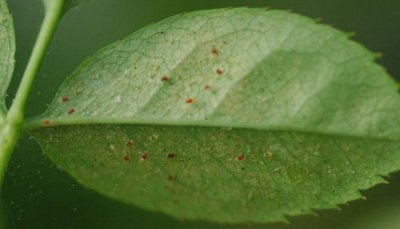

Spider mites are another common parasite on lemon. There are yellow, red, white, transparent types of spider mites.
It can be found on the stem and the underside of the leaves, the sap of which it feeds on. In the process, the leaves begin to turn yellow and dry for no apparent reason.
It is not easy to spot the pest, considering its size is 1–2 mm. But the cobweb on the underside of the leaf is clearly visible, as are the yellow dots in the places of its attachment.
Another tree sprayed with sulfur, insecticides, rub the leaves with alcohol... But the most effective and harmless way is ultraviolet. Two minutes warming up under an ultraviolet lamp has a detrimental effect on the tick... In addition, this method helps to heal and strengthen the plant.
In this article, we found out such questions as: why does a lemon lose its leaves and what to do while doing this, what to do if the lemon tree is withered.
The main thing is to properly care for the lemon, as well as to identify and take action in time for various diseases and the presence of parasites. Then the lemon tree will delight the eye with green foliage and juicy fragrant fruits for a long time.
Description of diseases and photos of affected areas
There are many diseases affecting the leaves of homemade lemon.
Chlorosis
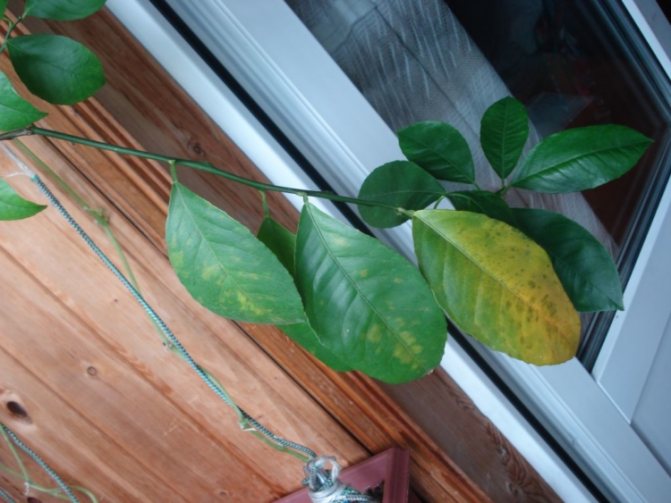

Chlorosis is a common indoor plant disease.It is caused by a violation of the formation of chlorophyll in the tissues of the leaf. The reason for this is lack of iron. It can occur due to soil depletion or excessive watering. Chlorosis is manifested by yellowing of the leaves.
Initially, yellow stripes are formed between the veins of the leaf. If you do not take action, the disease progresses, covering the entire plant. The growth of shoots becomes smaller, new leaves are small in size, quickly turn yellow and wither.
To treat chlorosis, you need to add iron to the plant's diet. in an easily digestible chelated form. To do this, you need to purchase a special drug (Ferovit, Ferrilene, Antichlorosis) or prepare the solution yourself.
To obtain an iron chelate at home, you will need to dilute 10 grams of ferrous sulfate in a liter of water, and then add 20 grams of ascorbic acid. The resulting solution is used for watering and spraying a sick lemon. Fertilizing through the leaf will have a more pronounced effect.
To prevent chlorosis, it is important to adhere to the following rules:
- choose the right soil (light, not too dense);
- monitor the acidity of the soil;
- Water the lemon with acidified water once a week.
Sooty fungus
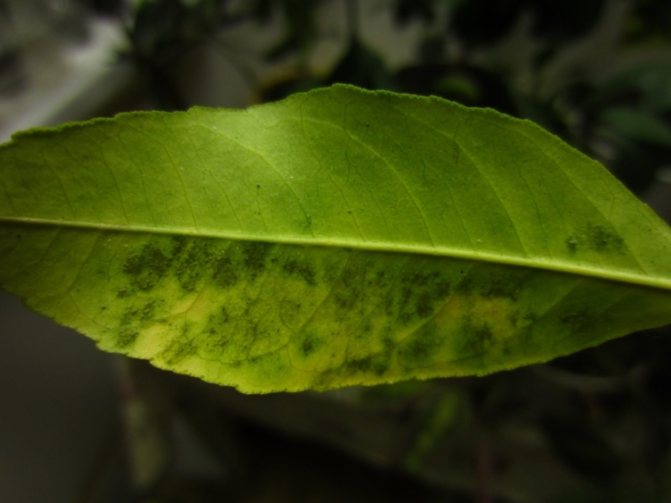

Sooty fungus is a byproduct of lemon pests, aphids or thyroid glands. Insects cover the leaves of the plant with a sticky secretion (paddy), creating a favorable environment for the growth of soot mold spores in the soil.
With this disease, the lemon becomes covered with a black bloom, which looks very much like soot. It is not only the leaves that suffer, but also the stems. The disease itself does not pose a serious danger, unlike the parasites that cause it.
Treatment tactics include, first of all, the destruction of insect pests. Then it is necessary to wash off the plaque from all parts of the plant, whitewash them with lime and thoroughly ventilate the room. Prevention of sooty fungus involves carefully examining the lemon for parasites.
Scab (Wart)


Scab is caused by a pathogenic fungus that is carried by insects. The disease develops rapidly in conditions of high humidity. When infected, bulging spots form on the leaves, branches and fruits, which then turn into holes.
The progression of the disease causes leaf fall, bark cracks and fruit defects. The affected parts of the plant will need to be removed, and healthy shoots will need to be treated with copper sulfate. The use of the drug Strobilin will also be effective. For preventive purposes, in the spring, lemon is sprayed with copper or iron sulfate.
Sheet mosaic
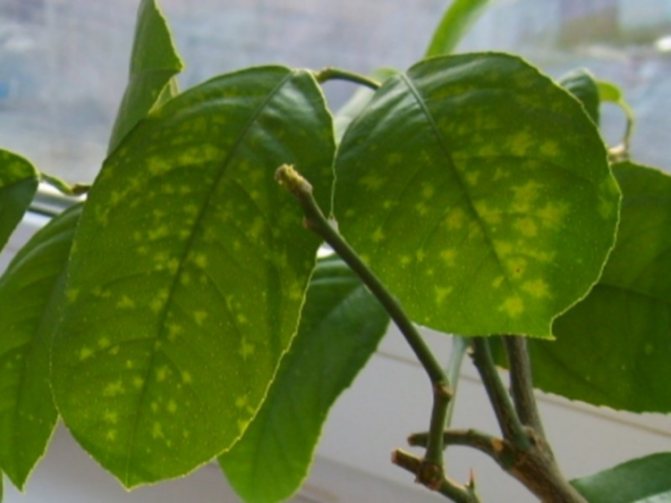

An infectious disease caused by a virus. It appears as a characteristic pattern on the leaves in the form of light spots and stripes. Over time, the leaves are deformed, lose their shape. The tree starts to fall behind in growth. An infected plant can survive long enough with good care.
It is better to destroy plants heavily damaged by infection.... Prevention consists in the timely detection of diseased plants, as well as preventive spraying with a weak solution of potassium permanganate.
Citrus Cancer


Citrus cancer is a disease caused by a virus. Infection occurs through damage on the ground part of the plant, as well as through the stomata of the leaves.
The first sign of the development of the disease is the appearance of dark brown spots on the leaves and stalks of lemon, resembling a tumor. Each of the spots has a depression in the center and is bordered by a yellow area.
Over time, formations appear on the fruits. Plants affected by the virus wither, begin to lag behind in development, shed their leaves and eventually die. There is no cure for the disease yet.... As a preventive measure, in the spring, lemon can be treated with copper preparations once.
Tristeza
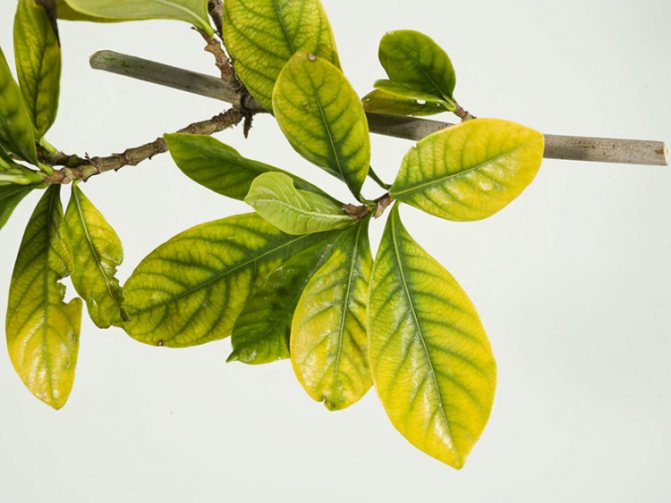

A viral disease that does not respond to treatment.The disease is caused by the Tristeza virus, which has about 30 variations. It is transmitted through insects and infected planting material. Outwardly, the infection manifests itself as massive yellowing and leaf shedding.
Before that, you can notice the thinning and lightening of the leaf veins. The virus then infects the bark and branches. Spreading through the vascular system of the plant, it disrupts the metabolism of nutrients.
As a result, the tree dies rather quickly. It is recommended to destroy lemon infected with tristeza.
Preventive measures include the use of virus-resistant planting and grafting material, as well as pest control.
Anthracnose


The disease is caused by pathogenic fungi that develop in conditions of high temperature and humidity. Initially, it is manifested by the appearance of dark brown spots on the tips of the leaves. In an advanced stage, the lemon leaves, ovaries and fruits fall.
Gum removal and necrosis of the shoots are often observed. Anthracnose can lead to the death of the aerial part of the plant. Treatment is possible at an early stage and includes the removal of damaged parts and treatment with fungicides. Such drugs as cope well with the disease:
- Fitosporin;
- copper oxychloride;
- bordeaux liquid.
Prevention consists in creating a temperature regime suitable for the plant and following the recommendations for watering.
Melsecco
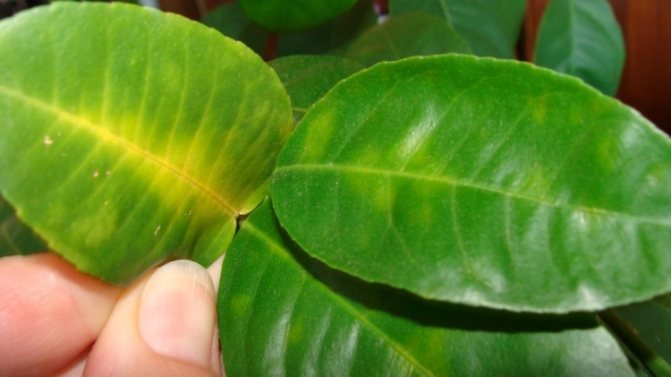

Melsecco is a dangerous, incurable disease of citrus fruits. The pathology is caused by parasitic fungi. The most serious forms lead to the death of the plant. Usually the disease starts with chlorosis of individual leaves, but at high temperatures progresses rapidly, causing wilting of shoots, foliage falling and drying of branches.
A characteristic feature of melsecco is the staining of wood in the affected areas in an orange-red color (usually this is clearly visible on the cut). There is no specific treatment for this disease.
Causes of viral diseases of lemons
First of all, it is worth understanding how lemon infection occurs.
1069; this will correct errors in the maintenance of your tree and prevent cases of reinfection.
Among the reasons leading to diseases, the following can be distinguished: - weak plant immunity after previously transferred.
085; drought, lack of light and mineral nutrition); - low quality soil; - location next to other diseased plants; - insects that can be transmitted. 085; various viruses or fungi (but the likelihood of this is very small).
Unfortunately, almost all viral diseases of lemons are incurable. Therefore, if you notice the symptoms of one of them, it is better to get rid of the diseased plant as soon as possible.
Consider the possible viral diseases of citrus fruits.
The appearance of sticky leaves
Every gardener, seeing a sticky bloom on lemon leaves, begins to worry and look for a solution to the problem. Many people think that some kind of parasite or disease has appeared on the lemon. But they are not always the cause. A sticky coating can appear due to a large amount of water: excess liquid sometimes manifests itself this way.
If you take a lemon that grows in its natural environment, then there with a sticky bloom it attracts ants to itself, and they allow you to fight pests. If the leaves are covered with bloom, then this is not always a bad thing.
The scaly parasite is usually responsible for the appearance of sticky leaves.
Indoor lemon pests
The most dangerous pests for lemon are spider mites and aphids. To prevent the house plant from being overpowered by such parasites, you should regularly spray the plant, and wipe the lemon leaves with a sponge every two weeks.
There are a lot of solutions for saving lemon from pests, here is some of them:
- Solution with soap and machine oil (oil can be replaced with kerosene or copper sulfate) - mix these components in a 1: 2 ratio and wipe the leaves thoroughly.After a couple of hours, wash them with clean water. Repeat in a week
- Mustard Soap Emulsion - dissolve 250 g of laundry soap in a bucket of water and 10 times less mustard powder, mix well. Pour 250 g of copper sulfate into the resulting solution
- Soak a sponge in a weak vinegar solution and wipe the leaves
- Lubricate the inside of the bucket turpentine and cover the plant. After a few hours, remove the container and wash the leaves with warm water
- 100 g hot pepper grind in 1 liter of water and cook for about an hour. After that, strain through cheesecloth and leave for two days. Dilute with water at a ratio of 1:10 before use
- 50 g garlic pass through the garlic and pour 300 g of hot water, leave for a week in a dark place. Add 350 g of soap before use and dilute in a bucket of water
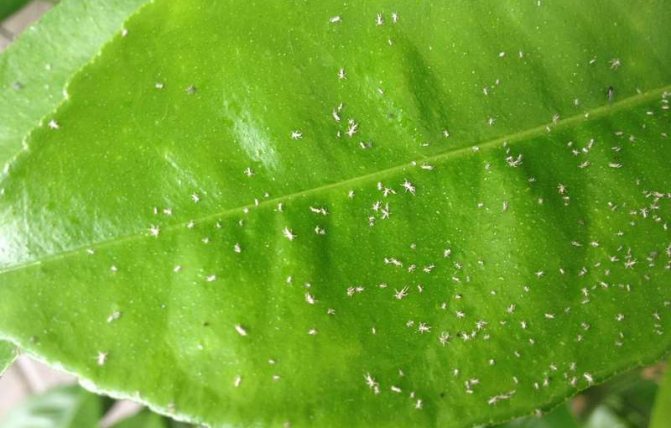

One of the enemies of indoor lemon is aphid
Don't put the lemon cure on the back burner. Pests will not leave the plant until you help. Wipe the leaves any of these solutions during the attack of pests and until you see a complete recovery of the plant. Spend preventive spraying citrus tree and then no parasites are afraid of him.
Citrus Cancer
Cancer is a dangerous disease in citrus fruits. Infection can occur through the stomata of the leaves or through various damage to the plant.


Its first symptom is dark brown spots on the leaves, similar to small tumors. Around each such spot there is a yellow area, and in the center of the spot there is a depression. Symptoms first appear on the leaves and their petioles, then, with the course of the disease, they appear on the fruits of the plant.
The diseased tree withers away, discards the affected leaves. Convex brown areas appear on the bark of the trunk. Shoots soon die off. Spots appear on lemon fruits, as well as on leaves. Only the skin of the fruit is affected. Most affected lemons do not fully ripen and fall off. There is no cure for cancer.
Wart
Wart is one of the diseases of lemons that occurs in indoor conditions. Young shoots, fruits and leaves are attacked by a pathogenic fungus.
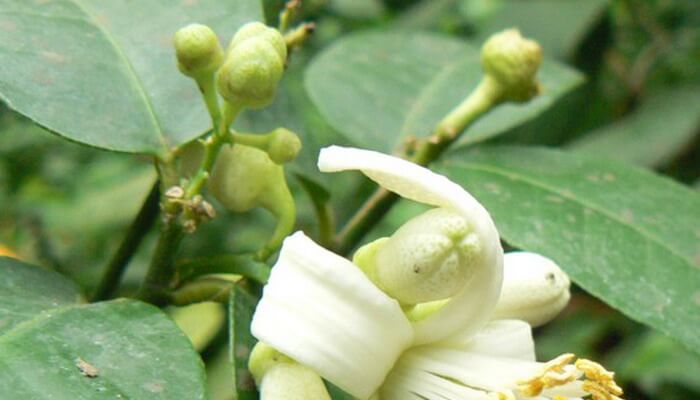

Small yellowish spots appear on the leaves, which after a while turn into gray warts. On the shoots, warts increase in size, forming large growths, which leads to the death of the shoot. Brown spots form on the fruits, the ovaries fall off. Wart develops rapidly in extreme heat and high humidity.
To eliminate this disease, the affected parts of the plant are cut off and burned, then the crown is sprayed with Bordeaux liquid. The first spraying is carried out in March, the second immediately after flowering, the third in July.
[collapse]
Scabbard Invasion
The scale insect is one of the most insidious lemon pests, which is sometimes very difficult to see with the naked eye. The first sign that a scale insect has settled on an indoor lemon is the presence of a transparent sticky coating on the leaves of the plant. Gradually, the affected lemon, being depleted, dries up and dies.
To combat this pest, modern chemicals are used, such as Fitoverm and Aktara. When spraying with these remedies, the juice of a room lemon, having absorbed the poison, itself becomes poisonous. Sucking out such juice, the scabbard inevitably dies. After carrying out such processing, it is important to remove the old top layer of the earth and replace it with a new one. As a rule, to achieve the desired result, it is necessary to carry out from three to five treatments, keeping an interval of two weeks between them. However, it should be borne in mind that after such a manipulation to save the plant, its fruits will be unusable.
We fight sticky plaque from pests
- It should be noted that the scabbard is covered with a dense waxy shell and cannot be destroyed immediately, so mechanical cleaning and spraying with chemicals will have to be repeated several times, every 3-4 days, until the spots completely disappear.
- When processing, you need to pay attention to the most inaccessible areas, including the underside of the leaf, its sinuses, internodes and the root zone.
- Chemical control methods can be alternated with less aggressive options. Mix in proportions: 15 ml of soap, 10 ml of 70% alcohol and 1 liter of water. Isolate the soil tightly from the ingress of liquid, apply the solution pointwise to the affected areas of the tree.
- If, despite efforts, new specks still appear on the lemon, it is recommended to use the preparations "Aktara" and "Confidor", the dilution method is written on the package, both are used for watering and spraying.


If other methods are ineffective to get rid of sticky plaque, you can use a special tool "Aktara"
How to plant a lemon?
A seed-grown lemon will most likely not bear fruit if not grafted. For, to get a citrus harvest you need:
- Cut off the scion just before grafting. It is better to do this between April and August.
- Trim the scion length 6 cm and remove all leaves except the top ones - leave about 4 sheets
- Make a cut from the top about 1 cm length and process the cut with a garden pitch
- Cut off half of each leaf on the scion, tie it to the stock with a tape, and place it under a glass tank or a large plastic bottle
- Through 2 weeks check how the grafting was started - whether the trimmed leaves come off easily


In order for a tree to bear fruit, it must be properly grafted.
If the leaves begin to fall over time, then this is a clear sign that tree grafting was successful and you can slightly loosen the tape with which you tied the scion and rootstock.
Usually such lemon grafting methods are successful and already a year after such a procedure You will see the first, unusually smelling white flowers, from which a delicious citrus fruit will grow over time.
Exposure to temperature
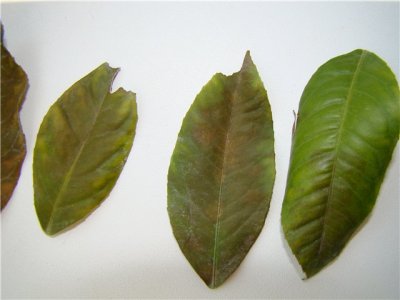

Lemon has the most high requirements for temperature, lighting and humidity... Leaves and trunk feel comfortable at 17 ° C, and for normal fruit ripening, at least 22-23 ° C is necessary.
Extremely negative plant reacts to sudden changes in temperature... A sharp drop in temperature, together with dry air, leads to inevitable stress. First, flowers and some ovaries begin to fall off, and then leaves. This is especially true in the autumn-winter period (you can find the rules for caring for indoor lemon in the fall here, and in this article we talked about how to care for a tree in winter).
The air temperature should be identical to the temperature of the soil in the pot. Such differences can occur if a lemon standing on the street and accustomed to a slight cold snap is dramatically brought into a heated room. The result can be the dropping of leaves.
Drafts and simultaneous currents of warm and cold air also have a negative effect. Under such unfavorable conditions, the lemon leaves begin to curl and curl and then fall off.
Why does a tree dry at home? What to do?
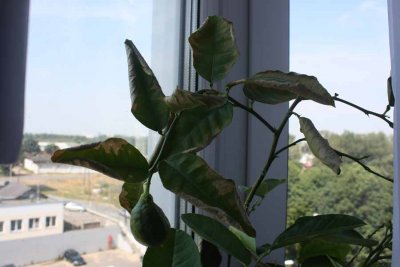

The most common cause of drying is the roots, or rather, their diseases. Improperly selected soil, excess moisture can create a favorable environment for the development of fungus that attacks the roots.
If the plant has been transplanted, then the new pot should be no more than 5 cm in diameter compared to the previous one. Otherwise, the soil will sour. And this again leads to decay of the roots. You can find the rules and recommendations for transplanting a lemon tree at home here, and from this article you will learn how to properly prepare the soil.
Leaves can dry out and in the presence of pests on the trunk and roots.
Too moving the pot frequently with a plant to new places can have a detrimental effect on its growth and vitality. Lemon simply begins to experience constant stress.
Dried up: how to revive?
If the reason for drying is a lack of watering and drying out of the soil, then the plant should be immediately pour over and cover with a plastic bag, providing him with greenhouse conditions.
You can also help lemon with a special citrus care fertilizer. Its introduction will give the plant additional impetus and strength.
Root rotting is caused by fungi, which can be destroyed by fungicides. After that, cut off the damaged parts of the root and sprinkle with crushed coal.
Gommoz
This disease occurs in the lower part of the trunk. Gradually rises up to the branches and down to the roots of the tree. In the lesion sites, bulges form, in which gum accumulates, which is a yellow or brown liquid that solidifies in air. The affected areas crack and die.
Read more: Cherry Bessey sand disease planting and care description of the variety
Gommosis often affects leaves and fruits. Brown spots appear on the leaves, which grow over time. On the affected fruits, the skin darkens and coarsens. The pulp softens, rots and takes on an unpleasant odor.
It is quite difficult to treat this disease. Sick areas are cleaned and treated with a solution of copper sulfate. After that, the tree is removed from the soil, its roots are cleaned and transplanted into fresh soil. Diseased bark and wood are cut out, all cleanings are burned.
Dry leaf tips and white spots on them
Leaf tips can dry out when:
- unsuitable microclimate;
- unbalanced lighting;
- mineral starvation;
- improperly selected soil for planting a plant;
- infestation with parasites.
Lemon leaves, covered with white bloom, indicate the appearance of a whitefly butterfly.
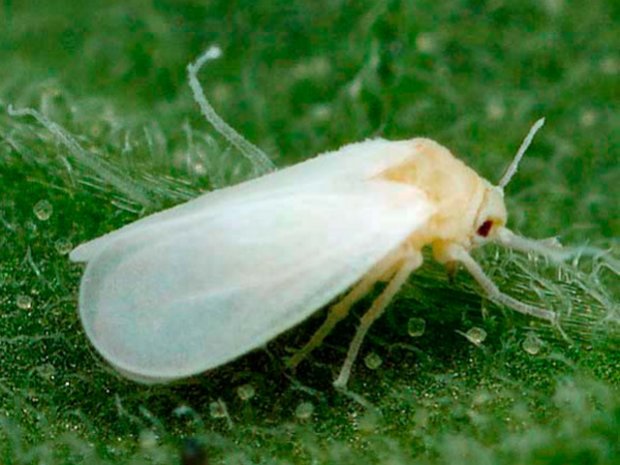

Whitefly butterfly
Detecting the parasite is simple:
- after shaking the branches, butterflies fly up;
- grayish-white formations that resemble mold appear on the leaves and shoots;
- the affected leaves curl, turn yellow and dry out.
Insect control methods:
- a few butterflies are destroyed by washing the leaves with gauze dipped in soapy water;
- sticky tapes for flies are hung next to the tree;
- spray the plant several times with a sweet solution (2 tablespoons of sugar are dissolved in a glass of water);
- a large number of insects can be defeated only with the help of special chemicals.


